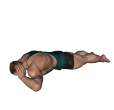 Back Extension - Basic
Back Extension - Basic
Benefits: This exercise has a different resistance curve from good mornings so these two exercises make a good combination. This exercise will also work the abs.
Purpose: This exercise strengthens the lower back muscles.
Beginner Lower Back Abdominals Strength Body Only Gym Home
General Info: The muscles of the lower back straighten the spine. They work together with the abdominals to keep the spine upright. The spine plays a big role in overall health, so the lower back is one of the most important muscle groups in the body.
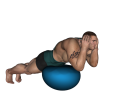 Back Extension - Fitness Ball
Back Extension - Fitness Ball
Benefits: This exercise has a different resistance curve from good mornings so these two exercises make a good combination. The exercise allows you to work the lower back without a workout partner or any specialized equipment (e.g., hyperextension bench).
Purpose: This exercise can be a powerful tool for developing the spinal erectors.
Intermediate Lower Back Hamstrings Glutes Strength Fitness Ball Pull Gym
General Info: The muscles of the lower back straighten the spine. They work together with the abdominals to keep the spine upright. The lower back consists of straight muscles.
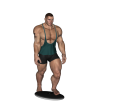 Balance - Board
Balance - Board
Benefits: A balance board is used to develop balance, motor coordination skills, weight distribution and core strength, to prepare you to avoid injurious falls, to prevent sports injuries especially to the ankle and knee, and for injury rehabilitation.
Purpose: The main aim of using a balance board is to improve proprioception. This is our sense and awareness of the position of our body parts. Having good proprioception helps to reduce the risk of injury.
Beginner Calves Quads Balance Board Functional Compound Gym Home
General Info: A balance board is a device used for recreation, balance training, athletic training, brain development, therapy, musical training and other kinds of personal development. There are four types of balance boards, each providing a different challenge. What differentiates the four types is how unstable each of them is (i.e., in how many and in which of the three dimensions of space each board turns and/or sways and how freely its fulcrum contacts the board and the ground). The four types are the rocker board which is similar to a teeter-totter., A wobble board that tilts toward 360 degrees, a rocker-roller board which is similar to the rocker board except that the fulcrum can move from one-end of the board to the other, and a sphere and ring board which provides the greatest freedom of movement in both transverse and longitudinal directions.
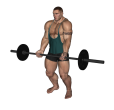 Barbell Curl - Basic
Barbell Curl - Basic
Benefits: This exercise works both heads of the biceps with a heavier weight than can typically be done with dumbbells. Moving the elbows out at the top of the movement ensures that the long head of the biceps (which crosses the shoulder joint) is also worked well.
Purpose: This exercise is used to target the biceps muscle to develop size, definition, strength, endurance and power.
Beginner Biceps Forearms Shoulders Strength Barbell Pull Gym
General Info: The biceps is a straight muscle with two heads. The long head of the biceps crosses both the elbow and the shoulder joint. It bends the elbow and raises the arm forward at the shoulder. The short head crosses the elbow joint and, in conjunction with the brachioradialis, supinates the hand.
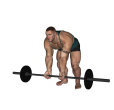 Barbell Curl - Bent Over
Barbell Curl - Bent Over
Benefits: This exercise is similar in effect to the Spider curl and does a good job of placing maximum tension on the biceps in the fully contracted position.
Purpose: This exercise works the biceps muscles but focuses also on the brachioradialis (a muscle that crosses the elbow joint and assists in rotating the forearm).
Beginner Biceps Forearms Shoulders Strength Barbell Pull Gym
General Info: The biceps is a straight muscle that has two heads. The long head crosses both the elbow and the shoulder joints. It bends the arm at the elbow and raises the arm forward at the shoulder. The short head crosses the elbow joint and, in conjunction with the brachioradialis, supinates the hand.
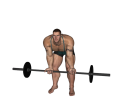 Barbell Curl - Bent Over Close Grip
Barbell Curl - Bent Over Close Grip
Benefits: This exercise is similar in effect to the Spider curl and does a good job of placing maximum tension on the biceps in the fully contracted position.
Purpose: This exercise works the biceps muscles but focuses also on the brachioradialis (a muscle that crosses the elbow joint and assists in rotating the forearm).
Beginner Biceps Forearms Shoulders Strength Barbell Pull Gym
General Info: The biceps is a straight muscle that has two heads. The long head crosses both the elbow and the shoulder joints. It bends the arm at the elbow and raises the arm forward at the shoulder. The short head crosses the elbow joint and, in conjunction with the brachioradialis, supinates the hand.
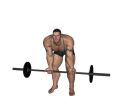 Barbell Curl - Bent Over Medium Grip
Barbell Curl - Bent Over Medium Grip
Benefits: This exercise is similar in effect to the Spider curl and does a good job of placing maximum tension on the biceps in the fully contracted position.
Purpose: This exercise works the biceps muscles but focuses also on the brachioradialis (a muscle that crosses the elbow joint and assists in rotating the forearm).
Beginner Biceps Forearms Shoulders Strength Barbell Pull Gym
General Info: The biceps is a straight muscle which has two heads. The long head crosses both the elbow and the shoulder joints. It bends the arm at the elbow and raises the arm forward at the shoulder. The short head crosses the elbow joint and, in conjunction with the brachioradialis, supinates the hand.
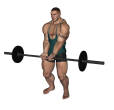 Barbell Curl - Close Grip Standing
Barbell Curl - Close Grip Standing
Benefits: This exercise works both heads of the biceps with a heavier weight than can typically be done with dumbbells. Using a close grip on the barbell gives you a different angle and feel for the exercise.
Purpose: This exercise is used to target the biceps muscle to develop size, definition, strength, endurance and power.
Beginner Biceps Forearms Strength Barbell Pull Gym
General Info: The biceps is a straight muscle with two heads. The long head of the biceps crosses both the elbow and the shoulder joint. It bends the elbow and raises the arm forward at the shoulder. The short head crosses the elbow joint and, in conjunction with the brachioradialis, supinates the hand.
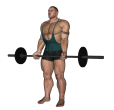 Barbell Curl - Drag
Barbell Curl - Drag
Benefits: This exercise works both heads of the biceps with a heavier weight than can typically be done with dumbbells. This exercise will go a long way toward eliminating anterior deltoid involvement as you curl, helping you isolate the working muscle in a way that the standard barbell may not.
Purpose: This exercise is used to target the biceps muscle to develop size, definition, strength, endurance and power.
Intermediate Biceps Forearms Shoulders Strength Barbell Pull Compound Gym
General Info: The biceps is a straight muscle with two heads. The long head of the biceps crosses both the elbow and the shoulder joint. It bends the elbow and raises the arm forward at the shoulder. The short head crosses the elbow joint and, in conjunction with the brachioradialis, supinates the hand.
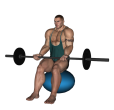 Barbell Curl - Fitness Ball
Barbell Curl - Fitness Ball
Benefits: This exercise isolates the biceps so that momentum does not come into play.
Purpose: This exercise strengthens the biceps.
Beginner Biceps Forearms Shoulders Traps Strength Barbell Fitness Ball Pull Gym
General Info: The biceps muscle is a straight muscle with 2 heads. The long head crosses both the elbow and shoulder joints and bends the elbow and raises the arm forward at the shoulder. The short head of the biceps crosses the elbow joint and, in conjunction with the brachioradialis, supinates the hand..
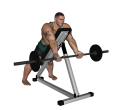 Barbell Curl - Incline
Barbell Curl - Incline
Benefits: This exercise allows a very complete range of motion compared to other curl movements.
Purpose: This exercise isolates the biceps muscles and reduces cheating in the curl movement.
Beginner Biceps Strength Barbell Incline Bench Pull Gym
General Info: The biceps is a straight muscle with two heads. The long head of the biceps crosses both the elbow and the shoulder joint. It bends the elbow and raises the arm forward at the shoulder. The short head crosses the elbow joint and, in conjunction with the brachioradialis, supinates the hand. This exercise is basically the same movement as a preacher curl, but the body is supported and the use of momentum is minimized.
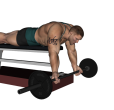 Barbell Curl - Lying High Bench
Barbell Curl - Lying High Bench
Benefits: This exercise is similar in effect to the Spider curl and does a good job of placing maximum tension on the biceps in the fully contracted position.
Purpose: This exercise works the biceps muscles.
Beginner Biceps Strength Barbell Flat Bench Pull Gym
General Info: The biceps muscle is a straight muscle with 2 heads. The long head crosses both the elbow and shoulder joints and bends the elbow and raises the arm forward at the shoulder. The short head of the biceps crosses the elbow joint and, in conjunction with the brachioradialis, supinates the hand.
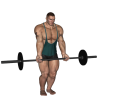 Barbell Curl - Narrow Stance
Barbell Curl - Narrow Stance
Benefits: This exercise works both heads of the biceps with a heavier weight than can typically be done with dumbbells. The narrow stance forces the stabilizing muscles to work harder in keeping the body upright.
Purpose: This exercise is used to target the biceps muscle to develop size, definition, strength, endurance and power.
Beginner Biceps Forearms Shoulders Strength Barbell Pull Gym
General Info: The biceps is a straight muscle with two heads. The long head of the biceps crosses both the elbow and the shoulder joint. It bends the elbow and raises the arm forward at the shoulder. The short head crosses the elbow joint and, in conjunction with the brachioradialis, supinates the hand.
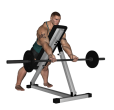 Barbell Curl - Overhang
Barbell Curl - Overhang
Benefits: This exercise is similar in effect to the Spider curl and does a good job of placing maximum tension on the biceps in the fully contracted position.
Purpose: This exercise works the biceps muscles.
Beginner Biceps Strength Barbell Incline Bench Pull Gym
General Info: The biceps muscle is a straight muscle with 2 heads. The long head crosses both the elbow and shoulder joints and bends the elbow and raises the arm forward at the shoulder. The short head of the biceps crosses the elbow joint and, in conjunction with the brachioradialis, supinates the hand.
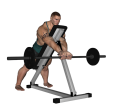 Barbell Curl - Overhang Close Grip
Barbell Curl - Overhang Close Grip
Benefits: This exercise does a good job of placing maximum tension on the biceps in the fully contracted position.
Purpose: This exercise works the biceps muscles.
Beginner Biceps Strength Barbell Incline Bench Pull Gym
General Info: The biceps muscle is a straight muscle with 2 heads. The long head crosses both the elbow and shoulder joints and bends the elbow and raises the arm forward at the shoulder. The short head of the biceps crosses the elbow joint and, in conjunction with the brachioradialis, supinates the hand.
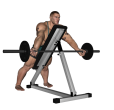 Barbell Curl - Overhang Wide Grip
Barbell Curl - Overhang Wide Grip
Benefits: This exercise does a good job of placing maximum tension on the biceps in the fully contracted position.
Purpose: This exercise works the biceps muscles.
Beginner Biceps Strength Barbell Incline Bench Pull Gym
General Info: The biceps muscle is a straight muscle with 2 heads. The long head crosses both the elbow and shoulder joints and bends the elbow and raises the arm forward at the shoulder. The short head of the biceps crosses the elbow joint and, in conjunction with the brachioradialis, supinates the hand.
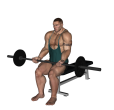 Barbell Curl - Seated
Barbell Curl - Seated
Benefits: This exercise isolates the biceps so that momentum does not come into play.
Purpose: This exercise strengthens the biceps.
Beginner Biceps Forearms Shoulders Traps Strength Barbell Flat Bench Pull Gym
General Info: The biceps muscle is a straight muscle with 2 heads. The long head crosses both the elbow and shoulder joints and bends the elbow and raises the arm forward at the shoulder. The short head of the biceps crosses the elbow joint and, in conjunction with the brachioradialis, supinates the hand..
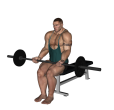 Barbell Curl - Seated Narrow Stance
Barbell Curl - Seated Narrow Stance
Benefits: This exercise isolates the biceps so that momentum does not come into play. the narrow stance forces the stabilizer muscles to assist in keeping the body upright.
Purpose: This exercise strengthens the biceps.
Beginner Biceps Forearms Shoulders Traps Strength Barbell Flat Bench Pull Gym
General Info: The biceps muscle is a straight muscle with 2 heads. The long head crosses both the elbow and shoulder joints and bends the elbow and raises the arm forward at the shoulder. The short head of the biceps crosses the elbow joint and, in conjunction with the brachioradialis, supinates the hand..
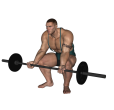 Barbell Curl - Squat
Barbell Curl - Squat
Benefits: This exercise isolates the biceps so that momentum does not come into play.
Purpose: This exercise strengthens the biceps.
Intermediate Biceps Forearms Shoulders Traps Strength Barbell Pull Gym
General Info: The biceps muscle is a straight muscle with 2 heads. The long head crosses both the elbow and shoulder joints and bends the elbow and raises the arm forward at the shoulder. The short head of the biceps crosses the elbow joint and, in conjunction with the brachioradialis, supinates the hand..
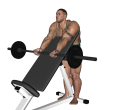 Barbell Curl - Standing Incline
Barbell Curl - Standing Incline
Benefits: This exercise works both heads of the biceps with a heavier weight than can typically be done with dumbbells. Placing the triceps on the incline bench makes the exercise similar to a preacher curl, which isolated the biceps.
Purpose: This exercise is used to target the biceps muscle to develop size, definition, strength, endurance and power.
Beginner Biceps Forearms Shoulders Strength Barbell Incline Bench Pull Gym
General Info: The biceps is a straight muscle with two heads. The long head of the biceps crosses both the elbow and the shoulder joint. It bends the elbow and raises the arm forward at the shoulder. The short head crosses the elbow joint and, in conjunction with the brachioradialis, supinates the hand.
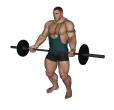 Barbell Curl - Wide Grip Standing
Barbell Curl - Wide Grip Standing
Benefits: This exercise works both heads of the biceps with a heavier weight than can typically be done with dumbbells. The wide grip gives you a different angle and feel to the exercise.
Purpose: This exercise is used to target the biceps muscle to develop size, definition, strength, endurance and power.
Beginner Biceps Forearms Shoulders Strength Barbell Pull Gym
General Info: The biceps is a straight muscle with two heads. The long head of the biceps crosses both the elbow and the shoulder joint. It bends the elbow and raises the arm forward at the shoulder. The short head crosses the elbow joint and, in conjunction with the brachioradialis, supinates the hand.
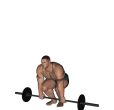 Barbell Press - Clean
Barbell Press - Clean
Benefits: This exercise also works the shoulders very well.
Purpose: To develop core strength of the lower and upper body.
Quads Glutes Hamstrings Calves Shoulders Strength Barbell Push Compound Gym
General Info: The quads are a set of four muscles in the upper front thigh. All four muscles work to straighten the knee. One of the four (rectus femoris) also helps to bend the hip. Squats are considered a vital exercise for increasing the strength and size of the legs and butt.
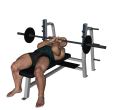 Barbell Press - Close Grip
Barbell Press - Close Grip
Benefits: This exercise works both heads of the triceps with a heavier weight than can typically be done with dumbbells. Note that the wider apart that you position your hands, the more the exercise works the chest and less the triceps.
Purpose: This exercise is used to target the triceps muscle to develop size, definition, strength, endurance and power.
Beginner Triceps Chest Shoulders Strength Barbell Flat Bench Push Compound Gym
General Info: The triceps is a straight muscle with three heads. The long head straightens the elbow, adducts the shoulder (brings it from a side position to the body) and extends the shoulder (brings the arm from a front position down to the body). The lateral head (outer head) straightens the elbow. The medial head also straightens the elbow.
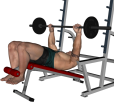 Barbell Press - Decline
Barbell Press - Decline
Benefits: This exercise works the chest muscles with a focus on your lower pecs.
Purpose: This exercise is used to target the lower pecs muscle to develop size, definition, strength, endurance and power.
Beginner Chest Triceps Shoulders Strength Barbell Decline Bench Push Compound Gym
General Info: The chest is composed of the Pectoralis Major and the Pectoralis Minor. The Pec Major attaches to the upper arm and pulls the upper arm across the chest. The Pec Minor lies mostly underneath the Pec Major and draws the shoulder blade down and forward.
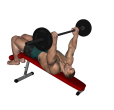 Barbell Press - Decline Guillotine
Barbell Press - Decline Guillotine
Benefits: This exercise works the chest muscles with a focus on your lower pecs.
Purpose: This exercise is used to target the lower pecs muscle to develop size, definition, strength, endurance and power.
Beginner Chest Triceps Shoulders Strength Barbell Decline Bench Push Compound Gym
General Info: The chest is composed of the Pectoralis Major and the Pectoralis Minor. The Pec Major attaches to the upper arm and pulls the upper arm across the chest. The Pec Minor lies mostly underneath the Pec Major and draws the shoulder blade down and forward.
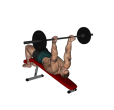 Barbell Press - Decline Reverse
Barbell Press - Decline Reverse
Benefits: This exercise works the chest muscles with a focus on your lower pecs.
Purpose: This exercise is used to target the lower pecs muscle to develop size, definition, strength, endurance and power.
Beginner Chest Triceps Shoulders Strength Barbell Decline Bench Push Compound Gym
General Info: The chest is composed of the Pectoralis Major and the Pectoralis Minor. The Pec Major attaches to the upper arm and pulls the upper arm across the chest. The Pec Minor lies mostly underneath the Pec Major and draws the shoulder blade down and forward.
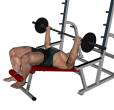 Barbell Press - Decline Reverse Wide Grip
Barbell Press - Decline Reverse Wide Grip
Benefits: This exercise works the chest muscles with a focus on your lower pecs.
Purpose: This exercise is used to target the lower pecs muscle to develop size, definition, strength, endurance and power.
Beginner Chest Triceps Shoulders Strength Barbell Decline Bench Push Compound Gym
General Info: The chest is composed of the Pectoralis Major and the Pectoralis Minor. The Pec Major attaches to the upper arm and pulls the upper arm across the chest. The Pec Minor lies mostly underneath the Pec Major and draws the shoulder blade down and forward.
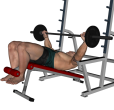 Barbell Press - Decline Wide Grip
Barbell Press - Decline Wide Grip
Benefits: This exercise works the chest muscles with a focus on your lower pecs.
Purpose: This exercise is used to target the lower pecs muscle to develop size, definition, strength, endurance and power.
Beginner Chest Triceps Shoulders Strength Barbell Decline Bench Push Compound Gym
General Info: The chest is composed of the Pectoralis Major and the Pectoralis Minor. The Pec Major attaches to the upper arm and pulls the upper arm across the chest. The Pec Minor lies mostly underneath the Pec Major and draws the shoulder blade down and forward.
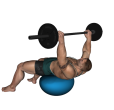 Barbell Press - Fitness Ball
Barbell Press - Fitness Ball
Benefits: A barbell allows someone to lift heavier weights and thus build more strength quicker.
Purpose: This exercise increases strength and strength speed, and produces greater functional strength for pressing movements.
Beginner Chest Triceps Anterior Delts Strength Barbell Fitness Ball Push Compound Gym
General Info: The chest is composed of the Pectoralis Major and the Pectoralis Minor. The Pec Major attaches to the upper arm and pulls the upper arm across the chest. The Pec Minor lies mostly underneath the Pec Major and draws the shoulder blade down and forward.
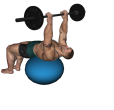 Barbell Press - Fitness Ball Guillotine
Barbell Press - Fitness Ball Guillotine
Benefits: A barbell allows someone to lift heavier weights and thus build more strength quicker.
Purpose: This exercise increases strength and strength speed, and produces greater functional strength for pressing movements.
Beginner Chest Triceps Anterior Delts Strength Barbell Fitness Ball Push Compound Gym
General Info: The chest is composed of the Pectoralis Major and the Pectoralis Minor. The Pec Major attaches to the upper arm and pulls the upper arm across the chest. The Pec Minor lies mostly underneath the Pec Major and draws the shoulder blade down and forward.
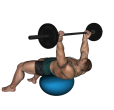 Barbell Press - Fitness Ball Reverse
Barbell Press - Fitness Ball Reverse
Benefits: A barbell allows someone to lift heavier weights and thus build more strength quicker.
Purpose: This exercise increases strength and strength speed, and produces greater functional strength for pressing movements.
Beginner Chest Triceps Anterior Delts Strength Barbell Fitness Ball Push Compound Gym
General Info: The chest is composed of the Pectoralis Major and the Pectoralis Minor. The Pec Major attaches to the upper arm and pulls the upper arm across the chest. The Pec Minor lies mostly underneath the Pec Major and draws the shoulder blade down and forward.
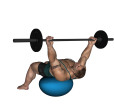 Barbell Press - Fitness Ball Reverse Wide
Barbell Press - Fitness Ball Reverse Wide
Benefits: A barbell allows someone to lift heavier weights and thus build more strength quicker.
Purpose: This exercise increases strength and strength speed, and produces greater functional strength for pressing movements.
Beginner Chest Triceps Anterior Delts Strength Barbell Fitness Ball Push Compound Gym
General Info: The chest is composed of the Pectoralis Major and the Pectoralis Minor. The Pec Major attaches to the upper arm and pulls the upper arm across the chest. The Pec Minor lies mostly underneath the Pec Major and draws the shoulder blade down and forward.
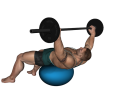 Barbell Press - Fitness Ball Wide Grip
Barbell Press - Fitness Ball Wide Grip
Benefits: A barbell allows someone to lift heavier weights and thus build more strength quicker.
Purpose: This exercise increases strength and strength speed, and produces greater functional strength for pressing movements.
Beginner Chest Triceps Anterior Delts Strength Barbell Fitness Ball Push Compound Gym
General Info: The chest is composed of the Pectoralis Major and the Pectoralis Minor. The Pec Major attaches to the upper arm and pulls the upper arm across the chest. The Pec Minor lies mostly underneath the Pec Major and draws the shoulder blade down and forward.
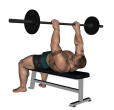 Barbell Press - Flat Bench
Barbell Press - Flat Bench
Benefits: This is the basic chest exercise.
Purpose: Benefits A barbell allows someone to lift heavier weights and thus build more strength quicker.
Beginner Chest Triceps Anterior Delts Strength Barbell Flat Bench Push Compound Gym
General Info: The chest is composed of the Pectoralis Major and the Pectoralis Minor. The Pec Major attaches to the upper arm and pulls the upper arm across the chest. The Pec Minor lies mostly underneath the Pec Major and draws the shoulder blade down and forward.
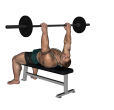 Barbell Press - Flat Bench and Flye
Barbell Press - Flat Bench and Flye
Benefits: A barbell allows someone to lift heavier weights and thus build more strength quicker.
Purpose: This exercise increases strength and strength speed, and produces greater functional strength for pressing movements.
Intermediate Chest Triceps Anterior Delts Strength Barbell Flat Bench Push Compound Gym
General Info: The chest is composed of the Pectoralis Major and the Pectoralis Minor. The Pec Major attaches to the upper arm and pulls the upper arm across the chest. The Pec Minor lies mostly underneath the Pec Major and draws the shoulder blade down and forward.
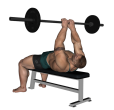 Barbell Press - Flat Bench Close Grip
Barbell Press - Flat Bench Close Grip
Benefits: This exercise works both heads of the triceps with a heavier weight than can typically be done with dumbbells. The closer you position your hands the more the exercise works the triceps.
Purpose: This exercise is used to target the triceps muscle to develop size, definition, strength, endurance and power.
Beginner Triceps Chest Shoulders Strength Barbell Flat Bench Push Compound Gym
General Info: The triceps is a straight muscle with three heads. The long head straightens the elbow, adducts the shoulder (brings it from a side position to the body) and extends the shoulder (brings the arm from a front position down to the body). The lateral head (outer head) straightens the elbow. The medial head also straightens the elbow.
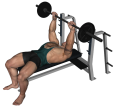 Barbell Press - Flat Bench Guillotine
Barbell Press - Flat Bench Guillotine
Benefits: A barbell allows someone to lift heavier weights and thus build more strength quicker.
Purpose: This exercise increases strength and strength speed, and produces greater functional strength for pressing movements.
Beginner Chest Triceps Anterior Delts Strength Barbell Flat Bench Push Compound Gym
General Info: The chest is composed of the Pectoralis Major and the Pectoralis Minor. The Pec Major attaches to the upper arm and pulls the upper arm across the chest. The Pec Minor lies mostly underneath the Pec Major and draws the shoulder blade down and forward.
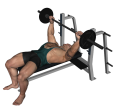 Barbell Press - Flat Bench Guillotine Wide Grip
Barbell Press - Flat Bench Guillotine Wide Grip
Benefits: A barbell allows someone to lift heavier weights and thus build more strength quicker.
Purpose: This exercise increases strength and strength speed, and produces greater functional strength for pressing movements.
Beginner Chest Triceps Anterior Delts Strength Barbell Flat Bench Push Compound Gym
General Info: The chest is composed of the Pectoralis Major and the Pectoralis Minor. The Pec Major attaches to the upper arm and pulls the upper arm across the chest. The Pec Minor lies mostly underneath the Pec Major and draws the shoulder blade down and forward.
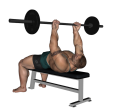 Barbell Press - Flat Bench Reverse
Barbell Press - Flat Bench Reverse
Benefits: A barbell allows someone to lift heavier weights and thus build more strength quicker. The reverse grip makes the exercise more difficult.
Purpose: This exercise increases strength and strength speed, and produces greater functional strength for pressing movements.
Beginner Chest Triceps Anterior Delts Strength Barbell Flat Bench Push Compound Gym
General Info: The chest is composed of the Pectoralis Major and the Pectoralis Minor. The Pec Major attaches to the upper arm and pulls the upper arm across the chest. The Pec Minor lies mostly underneath the Pec Major and draws the shoulder blade down and forward.
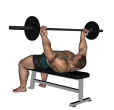 Barbell Press - Flat Bench Reverse Wide
Barbell Press - Flat Bench Reverse Wide
Benefits: A barbell allows someone to lift heavier weights and thus build more strength quicker. The reverse grip makes the exercise more difficult.
Purpose: This exercise increases strength and strength speed, and produces greater functional strength for pressing movements.
Beginner Chest Triceps Anterior Delts Strength Barbell Flat Bench Push Compound Gym
General Info: The chest is composed of the Pectoralis Major and the Pectoralis Minor. The Pec Major attaches to the upper arm and pulls the upper arm across the chest. The Pec Minor lies mostly underneath the Pec Major and draws the shoulder blade down and forward.
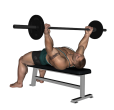 Barbell Press - Flat Bench Reverse Wide Feet Up
Barbell Press - Flat Bench Reverse Wide Feet Up
Benefits: A barbell allows someone to lift heavier weights and thus build more strength quicker.
Purpose: This exercise increases strength and strength speed, and produces greater functional strength for pressing movements.
Beginner Chest Triceps Anterior Delts Strength Barbell Flat Bench Push Compound Gym
General Info: The chest is composed of the Pectoralis Major and the Pectoralis Minor. The Pec Major attaches to the upper arm and pulls the upper arm across the chest. The Pec Minor lies mostly underneath the Pec Major and draws the shoulder blade down and forward.
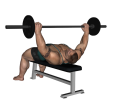 Barbell Press - Flat Bench Wide Grip
Barbell Press - Flat Bench Wide Grip
Benefits: A barbell allows someone to lift heavier weights and thus build more strength quicker.
Purpose: This exercise increases strength and strength speed, and produces greater functional strength for pressing movements.
Beginner Chest Triceps Anterior Delts Strength Barbell Flat Bench Push Compound Gym
General Info: The chest is composed of the Pectoralis Major and the Pectoralis Minor. The Pec Major attaches to the upper arm and pulls the upper arm across the chest. The Pec Minor lies mostly underneath the Pec Major and draws the shoulder blade down and forward.
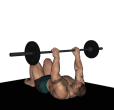 Barbell Press - Floor
Barbell Press - Floor
Benefits: A barbell allows someone to lift heavier weights and thus build more strength quicker.
Purpose: This exercise increases strength and strength speed, and produces greater functional strength for pressing movements.
Beginner Chest Triceps Anterior Delts Strength Barbell Push Compound Gym
General Info: The chest is composed of the Pectoralis Major and the Pectoralis Minor. The Pec Major attaches to the upper arm and pulls the upper arm across the chest. The Pec Minor lies mostly underneath the Pec Major and draws the shoulder blade down and forward.
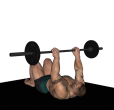 Barbell Press - Floor and Flye
Barbell Press - Floor and Flye
Benefits: A barbell allows someone to lift heavier weights and thus build more strength quicker. While this is primarily a chest movement, it also works the anterior deltoids.
Purpose: This exercise increases strength and strength speed, and produces greater functional strength for pressing movements.
Intermediate Chest Triceps Anterior Delts Strength Barbell Push Compound Gym
General Info: The chest is composed of the Pectoralis Major and the Pectoralis Minor. The Pec Major attaches to the upper arm and pulls the upper arm across the chest. The Pec Minor lies mostly underneath the Pec Major and draws the shoulder blade down and forward.
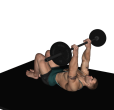 Barbell Press - Floor Guillotine
Barbell Press - Floor Guillotine
Benefits: A barbell allows someone to lift heavier weights and thus build more strength quicker.
Purpose: This exercise increases strength and strength speed, and produces greater functional strength for pressing movements.
Beginner Chest Triceps Anterior Delts Strength Barbell Push Compound Gym
General Info: The chest is composed of the Pectoralis Major and the Pectoralis Minor. The Pec Major attaches to the upper arm and pulls the upper arm across the chest. The Pec Minor lies mostly underneath the Pec Major and draws the shoulder blade down and forward.
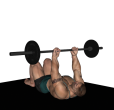 Barbell Press - Floor Reverse
Barbell Press - Floor Reverse
Benefits: A barbell allows someone to lift heavier weights and thus build more strength quicker. The reverse grip makes the exercise more difficult.
Purpose: This exercise increases strength and strength speed, and produces greater functional strength for pressing movements.
Beginner Chest Triceps Anterior Delts Strength Barbell Push Compound Gym
General Info: The chest is composed of the Pectoralis Major and the Pectoralis Minor. The Pec Major attaches to the upper arm and pulls the upper arm across the chest. The Pec Minor lies mostly underneath the Pec Major and draws the shoulder blade down and forward.
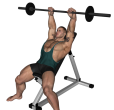 Barbell Press - Incline
Barbell Press - Incline
Benefits: This exercise works the chest muscles with a focus on your upper pecs. You can usually set the incline bench to different angles from the horizontal. The more of an angle you use, the more you are working the upper pecs.
Purpose: This exercise is used to target the upper pecs muscle to develop size, definition, strength, endurance and power.
Beginner Chest Triceps Shoulders Strength Barbell Incline Bench Push Compound Gym
General Info: The chest is composed of the Pectoralis Major and the Pectoralis Minor. The Pec Major attaches to the upper arm and pulls the upper arm across the chest. The Pec Minor lies mostly underneath the Pec Major and draws the shoulder blade down and forward.
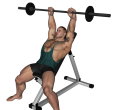 Barbell Press - Incline and Flye
Barbell Press - Incline and Flye
Benefits: A barbell allows someone to lift heavier weights and thus build more strength quicker. While this is primarily a chest movement, it also works the anterior deltoids.
Purpose: This exercise increases strength and strength speed, and produces greater functional strength for pressing movements.
Intermediate Chest Triceps Anterior Delts Strength Barbell Incline Bench Push Compound Gym
General Info: The chest is composed of the Pectoralis Major and the Pectoralis Minor. The Pec Major attaches to the upper arm and pulls the upper arm across the chest. The Pec Minor lies mostly underneath the Pec Major and draws the shoulder blade down and forward.
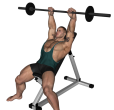 Barbell Press - Incline Guillotine
Barbell Press - Incline Guillotine
Benefits: A barbell allows someone to lift heavier weights and thus build more strength quicker.
Purpose: This exercise increases strength and strength speed, and produces greater functional strength for pressing movements.
Beginner Chest Triceps Anterior Delts Strength Barbell Incline Bench Push Compound Gym
General Info: The chest is composed of the Pectoralis Major and the Pectoralis Minor. The Pec Major attaches to the upper arm and pulls the upper arm across the chest. The Pec Minor lies mostly underneath the Pec Major and draws the shoulder blade down and forward.
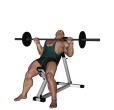 Barbell Press - Incline Medium Grip
Barbell Press - Incline Medium Grip
Benefits: This exercise works the chest muscles with a focus on your upper pecs.
Purpose: This exercise is used to target the upper pecs muscle to develop size, definition, strength, endurance and power.
Beginner Chest Triceps Shoulders Strength Barbell Incline Bench Push Compound Gym
General Info: The chest is composed of the Pectoralis Major and the Pectoralis Minor. The Pec Major attaches to the upper arm and pulls the upper arm across the chest. The Pec Minor lies mostly underneath the Pec Major and draws the shoulder blade down and forward.
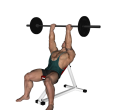 Barbell Press - Incline Reverse
Barbell Press - Incline Reverse
Benefits: A barbell allows someone to lift heavier weights and thus build more strength quicker.
Purpose: This exercise increases strength and strength speed, and produces greater functional strength for pressing movements.
Beginner Chest Triceps Anterior Delts Strength Barbell Incline Bench Push Compound Gym
General Info: The chest is composed of the Pectoralis Major and the Pectoralis Minor. The Pec Major attaches to the upper arm and pulls the upper arm across the chest. The Pec Minor lies mostly underneath the Pec Major and draws the shoulder blade down and forward.
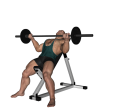 Barbell Press - Incline Reverse Wide
Barbell Press - Incline Reverse Wide
Benefits: A barbell allows someone to lift heavier weights and thus build more strength quicker.
Purpose: This exercise increases strength and strength speed, and produces greater functional strength for pressing movements.
Beginner Chest Triceps Anterior Delts Strength Barbell Incline Bench Push Compound Gym
General Info: The chest is composed of the Pectoralis Major and the Pectoralis Minor. The Pec Major attaches to the upper arm and pulls the upper arm across the chest. The Pec Minor lies mostly underneath the Pec Major and draws the shoulder blade down and forward.
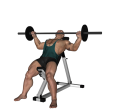 Barbell Press - Incline Wide Grip
Barbell Press - Incline Wide Grip
Benefits: This exercise works the chest muscles with a focus on your upper pecs.
Purpose: This exercise is used to target the upper pecs muscle to develop size, definition, strength, endurance and power.
Beginner Chest Triceps Shoulders Strength Barbell Incline Bench Push Compound Gym
General Info: The chest is composed of the Pectoralis Major and the Pectoralis Minor. The Pec Major attaches to the upper arm and pulls the upper arm across the chest. The Pec Minor lies mostly underneath the Pec Major and draws the shoulder blade down and forward.
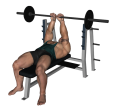 Barbell Press - JM
Barbell Press - JM
Benefits: A barbell allows someone to lift heavier weights and thus build more strength quicker.
Purpose: This exercise increases strength and strength speed, and produces greater functional strength for pressing movements.
Intermediate Chest Triceps Anterior Delts Strength Barbell Flat Bench Push Compound Gym
General Info: The chest is composed of the Pectoralis Major and the Pectoralis Minor. The Pec Major attaches to the upper arm and pulls the upper arm across the chest. The Pec Minor lies mostly underneath the Pec Major and draws the shoulder blade down and forward.
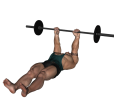 Barbell Press - Lying Floor
Barbell Press - Lying Floor
Benefits: A barbell allows someone to lift heavier weights and thus build more strength quicker.
Purpose: This exercise increases strength and strength speed, and produces greater functional strength for pressing movements.
Beginner Chest Triceps Anterior Delts Strength Barbell Push Compound Gym
General Info: The chest is composed of the Pectoralis Major and the Pectoralis Minor. The Pec Major attaches to the upper arm and pulls the upper arm across the chest. The Pec Minor lies mostly underneath the Pec Major and draws the shoulder blade down and forward.
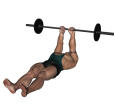 Barbell Press - Lying Floor Close Grip
Barbell Press - Lying Floor Close Grip
Benefits: The exercise eliminates isolates the triceps.
Purpose: This exercise works primarily the triceps.
Intermediate Chest Triceps Anterior Delts Strength Barbell Push Compound Gym
General Info: The triceps is a straight muscle with three heads. The long head straightens the elbow, adducts the shoulder (brings it from a side position to the body) and extends the shoulder (brings the arm from a front position down to the body). The lateral head (outer head) straightens the elbow. The medial head also straightens the elbow.
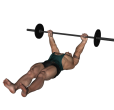 Barbell Press - Lying Floor Wide Grip
Barbell Press - Lying Floor Wide Grip
Benefits: A barbell allows someone to lift heavier weights and thus build more strength quicker.
Purpose: This exercise increases strength and strength speed, and produces greater functional strength for pressing movements.
Beginner Chest Triceps Anterior Delts Strength Barbell Push Compound Gym
General Info: The chest is composed of the Pectoralis Major and the Pectoralis Minor. The Pec Major attaches to the upper arm and pulls the upper arm across the chest. The Pec Minor lies mostly underneath the Pec Major and draws the shoulder blade down and forward.
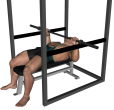 Barbell Press - Pin
Barbell Press - Pin
Benefits: A barbell allows someone to lift heavier weights and thus build more strength quicker. This exercise can be used for focusing on a desired point in the range of motion.
Purpose: This exercise increases strength and strength speed, and produces greater functional strength for pressing movements.
Intermediate Chest Triceps Anterior Delts Strength Power Rack Barbell Push Compound Gym
General Info: The chest is composed of the Pectoralis Major and the Pectoralis Minor. The Pec Major attaches to the upper arm and pulls the upper arm across the chest. The Pec Minor lies mostly underneath the Pec Major and draws the shoulder blade down and forward.
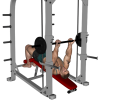 Barbell Press - Smith Decline Reverse Guillotine
Barbell Press - Smith Decline Reverse Guillotine
Benefits: A barbell allows someone to lift heavier weights and thus build more strength quicker. The reverse grip makes the exercise more difficult.
Purpose: This exercise increases strength and strength speed, and produces greater functional strength for pressing movements in the lower pecs.
Intermediate Chest Triceps Anterior Delts Strength Smith Machine Decline Bench Push Compound Gym
General Info: The chest is composed of the Pectoralis Major and the Pectoralis Minor. The Pec Major attaches to the upper arm and pulls the upper arm across the chest. The Pec Minor lies mostly underneath the Pec Major and draws the shoulder blade down and forward.
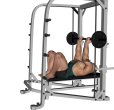 Barbell Press - Smith Feet Up Reverse Guillotine
Barbell Press - Smith Feet Up Reverse Guillotine
Benefits: A barbell allows someone to lift heavier weights and thus build more strength quicker. The reverse grip makes the exercise more difficult.
Purpose: This exercise increases strength and strength speed, and produces greater functional strength for pressing movements.
Intermediate Chest Triceps Anterior Delts Strength Smith Machine Flat Bench Push Compound Gym
General Info: The chest is composed of the Pectoralis Major and the Pectoralis Minor. The Pec Major attaches to the upper arm and pulls the upper arm across the chest. The Pec Minor lies mostly underneath the Pec Major and draws the shoulder blade down and forward.
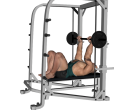 Barbell Press - Smith Flat Feet Up Guillotine
Barbell Press - Smith Flat Feet Up Guillotine
Benefits: A barbell allows someone to lift heavier weights and thus build more strength quicker.
Purpose: This exercise increases strength and strength speed, and produces greater functional strength for pressing movements.
Intermediate Chest Triceps Anterior Delts Strength Smith Machine Flat Bench Push Compound Gym
General Info: The chest is composed of the Pectoralis Major and the Pectoralis Minor. The Pec Major attaches to the upper arm and pulls the upper arm across the chest. The Pec Minor lies mostly underneath the Pec Major and draws the shoulder blade down and forward.
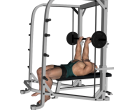 Barbell Press - Smith Flat Reverse Guillotine
Barbell Press - Smith Flat Reverse Guillotine
Benefits: A barbell allows someone to lift heavier weights and thus build more strength quicker. The reverse grip makes the exercise more difficult.
Purpose: This exercise increases strength and strength speed, and produces greater functional strength for pressing movements.
Intermediate Chest Triceps Anterior Delts Strength Smith Machine Flat Bench Push Compound Gym
General Info: The chest is composed of the Pectoralis Major and the Pectoralis Minor. The Pec Major attaches to the upper arm and pulls the upper arm across the chest. The Pec Minor lies mostly underneath the Pec Major and draws the shoulder blade down and forward.
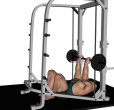 Barbell Press - Smith Floor Guillotine Reverse
Barbell Press - Smith Floor Guillotine Reverse
Benefits: A barbell allows someone to lift heavier weights and thus build more strength quicker. The reverse grip makes the exercise more difficult.
Purpose: This exercise increases strength and strength speed, and produces greater functional strength for pressing movements.
Intermediate Chest Triceps Anterior Delts Strength Smith Machine Push Compound Gym
General Info: The chest is composed of the Pectoralis Major and the Pectoralis Minor. The Pec Major attaches to the upper arm and pulls the upper arm across the chest. The Pec Minor lies mostly underneath the Pec Major and draws the shoulder blade down and forward.
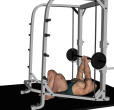 Barbell Press - Smith Floor Reverse Close Grip
Barbell Press - Smith Floor Reverse Close Grip
Benefits: The exercise eliminates isolates the triceps. The reverse grip makes the exercise more difficult.
Purpose: This exercise works primarily the triceps.
Intermediate Chest Triceps Anterior Delts Strength Smith Machine Push Compound Gym
General Info: The triceps is a straight muscle with three heads. The long head straightens the elbow, adducts the shoulder (brings it from a side position to the body) and extends the shoulder (brings the arm from a front position down to the body). The lateral head (outer head) straightens the elbow. The medial head also straightens the elbow.
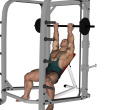 Barbell Press - Smith Incline Reverse Guillotine
Barbell Press - Smith Incline Reverse Guillotine
Benefits: A barbell allows someone to lift heavier weights and thus build more strength quicker. The reverse grip makes the exercise more difficult.
Purpose: This exercise increases strength and strength speed, and produces greater functional strength for pressing movements.
Intermediate Chest Triceps Anterior Delts Strength Smith Machine Incline Bench Push Compound Gym
General Info: The chest is composed of the Pectoralis Major and the Pectoralis Minor. The Pec Major attaches to the upper arm and pulls the upper arm across the chest. The Pec Minor lies mostly underneath the Pec Major and draws the shoulder blade down and forward.
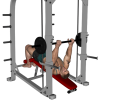 Barbell Press - Smith Machine Decline Guillotine
Barbell Press - Smith Machine Decline Guillotine
Benefits: A barbell allows someone to lift heavier weights and thus build more strength quicker.
Purpose: This exercise increases strength and strength speed, and produces greater functional strength for pressing movements.
Intermediate Chest Triceps Anterior Delts Strength Smith Machine Decline Bench Push Compound Gym
General Info: The chest is composed of the Pectoralis Major and the Pectoralis Minor. The Pec Major attaches to the upper arm and pulls the upper arm across the chest. The Pec Minor lies mostly underneath the Pec Major and draws the shoulder blade down and forward.
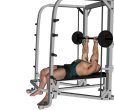 Barbell Press - Smith Machine Flat Guillotine
Barbell Press - Smith Machine Flat Guillotine
Benefits: A barbell allows someone to lift heavier weights and thus build more strength quicker.
Purpose: This exercise increases strength and strength speed, and produces greater functional strength for pressing movements.
Intermediate Chest Triceps Anterior Delts Strength Smith Machine Flat Bench Push Compound Gym
General Info: The chest is composed of the Pectoralis Major and the Pectoralis Minor. The Pec Major attaches to the upper arm and pulls the upper arm across the chest. The Pec Minor lies mostly underneath the Pec Major and draws the shoulder blade down and forward.
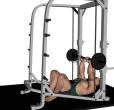 Barbell Press - Smith Machine Floor
Barbell Press - Smith Machine Floor
Benefits: A barbell allows someone to lift heavier weights and thus build more strength quicker.
Purpose: This exercise increases strength and strength speed, and produces greater functional strength for pressing movements.
Intermediate Chest Triceps Anterior Delts Strength Smith Machine Push Compound Gym
General Info: The chest is composed of the Pectoralis Major and the Pectoralis Minor. The Pec Major attaches to the upper arm and pulls the upper arm across the chest. The Pec Minor lies mostly underneath the Pec Major and draws the shoulder blade down and forward.
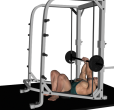 Barbell Press - Smith Machine Floor Close Grip
Barbell Press - Smith Machine Floor Close Grip
Benefits: The exercise eliminates isolates the triceps.
Purpose: This exercise works primarily the triceps.
Intermediate Chest Triceps Anterior Delts Strength Smith Machine Push Compound Gym
General Info: The triceps is a straight muscle with three heads. The long head straightens the elbow, adducts the shoulder (brings it from a side position to the body) and extends the shoulder (brings the arm from a front position down to the body). The lateral head (outer head) straightens the elbow. The medial head also straightens the elbow.
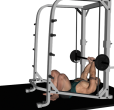 Barbell Press - Smith Machine Floor Guillotine
Barbell Press - Smith Machine Floor Guillotine
Benefits: A barbell allows someone to lift heavier weights and thus build more strength quicker.
Purpose: This exercise increases strength and strength speed, and produces greater functional strength for pressing movements.
Intermediate Chest Triceps Anterior Delts Strength Smith Machine Push Compound Gym
General Info: The chest is composed of the Pectoralis Major and the Pectoralis Minor. The Pec Major attaches to the upper arm and pulls the upper arm across the chest. The Pec Minor lies mostly underneath the Pec Major and draws the shoulder blade down and forward.
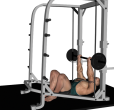 Barbell Press - Smith Machine Floor Reverse
Barbell Press - Smith Machine Floor Reverse
Benefits: A barbell allows someone to lift heavier weights and thus build more strength quicker. The reverse grip makes the exercise more difficult.
Purpose: This exercise increases strength and strength speed, and produces greater functional strength for pressing movements.
Intermediate Chest Triceps Anterior Delts Strength Smith Machine Push Compound Gym
General Info: The chest is composed of the Pectoralis Major and the Pectoralis Minor. The Pec Major attaches to the upper arm and pulls the upper arm across the chest. The Pec Minor lies mostly underneath the Pec Major and draws the shoulder blade down and forward.
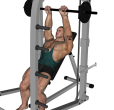 Barbell Press - Smith Machine Incline Guillotine
Barbell Press - Smith Machine Incline Guillotine
Benefits: A barbell allows someone to lift heavier weights and thus build more strength quicker.
Purpose: This exercise increases strength and strength speed, and produces greater functional strength for pressing movements.
Intermediate Chest Triceps Anterior Delts Strength Smith Machine Incline Bench Push Compound Gym
General Info: The chest is composed of the Pectoralis Major and the Pectoralis Minor. The Pec Major attaches to the upper arm and pulls the upper arm across the chest. The Pec Minor lies mostly underneath the Pec Major and draws the shoulder blade down and forward.
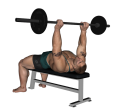 Barbell Press - To Neck
Barbell Press - To Neck
Benefits: A barbell allows someone to lift heavier weights and thus build more strength quicker.
Purpose: This exercise increases strength and strength speed, and produces greater functional strength for pressing movements.
Beginner Chest Triceps Anterior Delts Strength Barbell Flat Bench Push Compound Gym
General Info: The chest is composed of the Pectoralis Major and the Pectoralis Minor. The Pec Major attaches to the upper arm and pulls the upper arm across the chest. The Pec Minor lies mostly underneath the Pec Major and draws the shoulder blade down and forward.
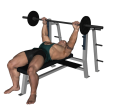 Barbell Press - Wide Grip
Barbell Press - Wide Grip
Benefits: A barbell allows someone to lift heavier weights and thus build more strength quicker.
Purpose: This exercise increases strength and strength speed, and produces greater functional strength for pressing movements.
Beginner Chest Triceps Anterior Delts Strength Barbell Flat Bench Push Compound Gym
General Info: The chest is composed of the Pectoralis Major and the Pectoralis Minor. The Pec Major attaches to the upper arm and pulls the upper arm across the chest. The Pec Minor lies mostly underneath the Pec Major and draws the shoulder blade down and forward.
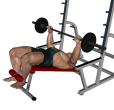 Barbell Press - Wide Grip Decline
Barbell Press - Wide Grip Decline
Benefits: This exercise works the chest muscles with a focus on your lower pecs.
Purpose: This exercise is used to target the lower pecs muscle to develop size, definition, strength, endurance and power.
Beginner Chest Triceps Shoulders Strength Barbell Decline Bench Push Compound Gym
General Info: The chest is composed of the Pectoralis Major and the Pectoralis Minor. The Pec Major attaches to the upper arm and pulls the upper arm across the chest. The Pec Minor lies mostly underneath the Pec Major and draws the shoulder blade down and forward.
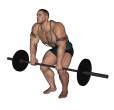 Barbell Row - Basic
Barbell Row - Basic
Benefits: This exercise is a strong, effective free weight back exercise for building muscle mass and size of the lats.
Purpose: This is a good exercise for increasing strength and size in the upper back.
Intermediate Traps Lats Triceps Posterior Delts Strength Barbell Pull Compound Gym
General Info: There are a number of muscles in the back, although the two major muscles are the lats and traps. The lats pulls the arm back and down towards the spine. The traps pull the shoulder blades back and towards the spine.
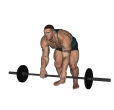 Barbell Row - Bent Over
Barbell Row - Bent Over
Benefits: This exercise is a strong, effective free weight back exercise for building muscle mass and size of the lats.
Purpose: This is a good exercise for increasing strength and size in the upper back.
Intermediate Traps Lats Triceps Posterior Delts Strength Barbell Pull Compound Gym
General Info: There are a number of muscles in the back, although the two major muscles are the lats and traps. The lats pulls the arm back and down towards the spine. The traps pull the shoulder blades back and towards the spine.
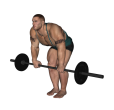 Barbell Row - Bent Over Narrow Stance
Barbell Row - Bent Over Narrow Stance
Benefits: This exercise is a strong, effective free weight back exercise for building muscle mass and size of the lats.
Purpose: This is a good exercise for increasing strength and size in the upper back.
Intermediate Traps Lats Triceps Posterior Delts Strength Barbell Pull Compound Gym
General Info: There are a number of muscles in the back, although the two major muscles are the lats and traps. The lats pulls the arm back and down towards the spine. The traps pull the shoulder blades back and towards the spine.
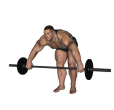 Barbell Row - Bent Over Wide Grip
Barbell Row - Bent Over Wide Grip
Benefits: This exercise is a strong, effective free weight back exercise for building muscle mass and size of the lats.
Purpose: This is a good exercise for increasing strength and size in the upper back.
Intermediate Traps Lats Triceps Posterior Delts Strength Barbell Pull Compound Gym
General Info: There are a number of muscles in the back, although the two major muscles are the lats and traps. The lats pulls the arm back and down towards the spine. The traps pull the shoulder blades back and towards the spine.
 Barbell Row - Bent Over Wide Grip Close Stance
Barbell Row - Bent Over Wide Grip Close Stance
Benefits: This exercise is a strong, effective free weight back exercise for building muscle mass and size of the lats.
Purpose: This is a good exercise for increasing strength and size in the upper back.
Intermediate Traps Lats Triceps Posterior Delts Strength Barbell Pull Compound Gym
General Info: There are a number of muscles in the back, although the two major muscles are the lats and traps. The lats pulls the arm back and down towards the spine. The traps pull the shoulder blades back and towards the spine.
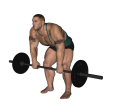 Barbell Row - Bent Over Wide Stance
Barbell Row - Bent Over Wide Stance
Benefits: This exercise is a strong, effective free weight back exercise for building muscle mass and size of the lats.
Purpose: This is a good exercise for increasing strength and size in the upper back.
Intermediate Traps Lats Triceps Posterior Delts Strength Barbell Pull Compound Gym
General Info: There are a number of muscles in the back, although the two major muscles are the lats and traps. The lats pulls the arm back and down towards the spine. The traps pull the shoulder blades back and towards the spine.
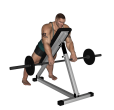 Barbell Row - Incline
Barbell Row - Incline
Benefits: This exercise is a strong, effective free weight back exercise for building muscle mass and size of the lats.
Purpose: This is a good exercise for increasing strength and size in the upper back.
Intermediate Traps Lats Triceps Posterior Delts Strength Barbell Incline Bench Pull Compound Gym
General Info: There are a number of muscles in the back, although the two major muscles are the lats and traps. The lats pulls the arm back and down towards the spine. The traps pull the shoulder blades back and towards the spine.
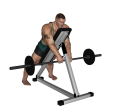 Barbell Row - Incline Close Grip
Barbell Row - Incline Close Grip
Benefits: This exercise is a strong, effective free weight back exercise for building muscle mass and size of the lats.
Purpose: This is a good exercise for increasing strength and size in the upper back.
Intermediate Traps Lats Triceps Posterior Delts Strength Barbell Incline Bench Pull Compound Gym
General Info: There are a number of muscles in the back, although the two major muscles are the lats and traps. The lats pulls the arm back and down towards the spine. The traps pull the shoulder blades back and towards the spine.
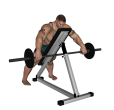 Barbell Row - Incline Wide Grip
Barbell Row - Incline Wide Grip
Benefits: This exercise is a strong, effective free weight back exercise for building muscle mass and size of the lats.
Purpose: This is a good exercise for increasing strength and size in the upper back.
Intermediate Traps Lats Triceps Posterior Delts Strength Barbell Incline Bench Pull Compound Gym
General Info: There are a number of muscles in the back, although the two major muscles are the lats and traps. The lats pulls the arm back and down towards the spine. The traps pull the shoulder blades back and towards the spine.
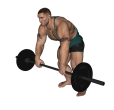 Barbell Row - Rear Delt
Barbell Row - Rear Delt
Benefits: This exercise isolates the posterior delt muscle.
Purpose: This exercise strengthens the rear deltoid muscle area.
Beginner Rear Shoulders Biceps Lats Traps Strength Barbell Pull Compound Gym
General Info: The posterior (rear) deltoid or shoulder is one of the three distinct heads of the deltoid anatomy. It is typically used in tandem with the back muscles during upper body pulling exercises.
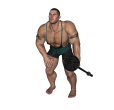 Barbell Row - Single Arm
Barbell Row - Single Arm
Benefits: This exercise is a strong, effective free weight back exercise for building muscle mass and size of the lats.
Purpose: This is a good exercise for increasing strength and size in the upper back.
Intermediate Traps Lats Triceps Posterior Delts Strength Barbell Pull Compound Gym
General Info: There are a number of muscles in the back, although the two major muscles are the lats and traps. The lats pulls the arm back and down towards the spine. The traps pull the shoulder blades back and towards the spine.
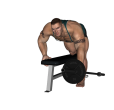 Barbell Row - Single Arm Bench
Barbell Row - Single Arm Bench
Benefits: This exercise is a strong, effective free weight back exercise for building muscle mass and size of the lats.
Purpose: This is a good exercise for increasing strength and size in the upper back.
Intermediate Traps Lats Triceps Posterior Delts Strength Barbell Flat Bench Pull Compound Gym
General Info: There are a number of muscles in the back, although the two major muscles are the lats and traps. The lats pulls the arm back and down towards the spine. The traps pull the shoulder blades back and towards the spine.
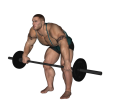 Barbell Row - Wide Grip
Barbell Row - Wide Grip
Benefits: This exercise is a strong, effective free weight back exercise for building muscle mass and size of the lats.
Purpose: This is a good exercise for increasing strength and size in the upper back.
Intermediate Traps Lats Triceps Posterior Delts Strength Barbell Pull Compound Gym
General Info: There are a number of muscles in the back, although the two major muscles are the lats and traps. The lats pulls the arm back and down towards the spine. The traps pull the shoulder blades back and towards the spine.
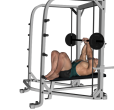 Bench Press - Close Grip Smith Machine Feet Up
Bench Press - Close Grip Smith Machine Feet Up
Benefits: This exercise works both heads of the triceps with a heavier weight than can typically be done with dumbbells.
Purpose: This exercise is used to target the triceps muscle to develop size, definition, strength, endurance and power.
Beginner Triceps Chest Shoulders Strength Smith Machine Flat Bench Push Compound Gym
General Info: The triceps is a straight muscle with three heads. The long head straightens the elbow, adducts the shoulder (brings it from a side position to the body) and extends the shoulder (brings the arm from a front position down to the body). The lateral head (outer head) straightens the elbow. The medial head also straightens the elbow.
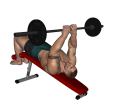 Bench Press - Decline Skull Crusher
Bench Press - Decline Skull Crusher
Benefits: This exercise works both heads of the triceps with a heavier weight than can typically be done with dumbbells.
Purpose: This exercise is used to target the triceps muscle to develop size, definition, strength, endurance and power.
Beginner Triceps Chest Shoulders Strength Barbell Decline Bench Push Compound Gym
General Info: The triceps is a straight muscle with three heads. The long head straightens the elbow, adducts the shoulder (brings it from a side position to the body) and extends the shoulder (brings the arm from a front position down to the body). The lateral head (outer head) straightens the elbow. The medial head also straightens the elbow.
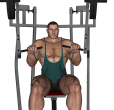 Bench Press - Machine
Bench Press - Machine
Benefits: A barbell allows someone to lift heavier weights and thus build more strength quicker.
Purpose: This exercise increases strength and strength speed, and produces greater functional strength for pressing movements.
Beginner Chest Triceps Anterior Delts Strength Chest Press Machine Push Compound Gym
General Info: The chest is composed of the Pectoralis Major and the Pectoralis Minor. The Pec Major attaches to the upper arm and pulls the upper arm across the chest. The Pec Minor lies mostly underneath the Pec Major and draws the shoulder blade down and forward.
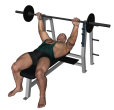 Bench Press - Medium Grip Barbell
Bench Press - Medium Grip Barbell
Benefits: A barbell allows someone to lift heavier weights and thus build more strength quicker.
Purpose: This exercise increases strength and strength speed, and produces greater functional strength for pressing movements.
Beginner Chest Triceps Anterior Delts Strength Barbell Flat Bench Push Compound Gym
General Info: The chest is composed of the Pectoralis Major and the Pectoralis Minor. The Pec Major attaches to the upper arm and pulls the upper arm across the chest. The Pec Minor lies mostly underneath the Pec Major and draws the shoulder blade down and forward.
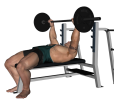 Bench Press - Powerlifting
Bench Press - Powerlifting
Benefits: A barbell allows someone to lift heavier weights and thus build more strength quicker.
Purpose: This exercise increases strength and strength speed, and produces greater functional strength for pressing movements.
Chest Triceps Anterior Delts Strength Barbell Flat Bench Push Compound Gym
General Info: The chest is composed of the Pectoralis Major and the Pectoralis Minor. The Pec Major attaches to the upper arm and pulls the upper arm across the chest. The Pec Minor lies mostly underneath the Pec Major and draws the shoulder blade down and forward.
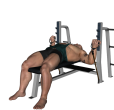 Bench Press - Reverse Band
Bench Press - Reverse Band
Benefits: A barbell allows someone to lift heavier weights and thus build more strength quicker.
Purpose: This exercise increases strength and strength speed, and produces greater functional strength for pressing movements.
Beginner Chest Triceps Anterior Delts Strength Power Rack Band Flat Bench Push Compound Gym
General Info: The chest is composed of the Pectoralis Major and the Pectoralis Minor. The Pec Major attaches to the upper arm and pulls the upper arm across the chest. The Pec Minor lies mostly underneath the Pec Major and draws the shoulder blade down and forward.
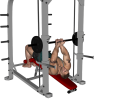 Bench Press - Smith Decline Reverse Close
Bench Press - Smith Decline Reverse Close
Benefits: This exercise works both heads of the triceps with a heavier weight than can typically be done with dumbbells. It also works the lower spec. The reverse grip makes the exercise more difficult.
Purpose: This exercise is used to target the triceps muscle to develop size, definition, strength, endurance and power.
Beginner Triceps Chest Shoulders Strength Smith Machine Decline Bench Push Compound Gym
General Info: The triceps is a straight muscle with three heads. The long head straightens the elbow, adducts the shoulder (brings it from a side position to the body) and extends the shoulder (brings the arm from a front position down to the body). The lateral head (outer head) straightens the elbow. The medial head also straightens the elbow.
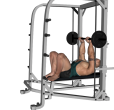 Bench Press - Smith Feet On Bench
Bench Press - Smith Feet On Bench
Benefits: A machine allows someone to lift heavier weights and thus build more strength quicker.
Purpose: This exercise increases strength and strength speed, and produces greater functional strength for pressing movements.
Beginner Chest Triceps Anterior Delts Strength Smith Machine Flat Bench Push Compound Gym
General Info: The chest is composed of the Pectoralis Major and the Pectoralis Minor. The Pec Major attaches to the upper arm and pulls the upper arm across the chest. The Pec Minor lies mostly underneath the Pec Major and draws the shoulder blade down and forward.
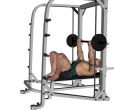 Bench Press - Smith Feet On Bench Reverse
Bench Press - Smith Feet On Bench Reverse
Benefits: A machine allows someone to lift heavier weights and thus build more strength quicker. The reverse grip makes the exercise more difficult.
Purpose: This exercise increases strength and strength speed, and produces greater functional strength for pressing movements.
Beginner Chest Triceps Anterior Delts Strength Smith Machine Flat Bench Push Compound Gym
General Info: The chest is composed of the Pectoralis Major and the Pectoralis Minor. The Pec Major attaches to the upper arm and pulls the upper arm across the chest. The Pec Minor lies mostly underneath the Pec Major and draws the shoulder blade down and forward.
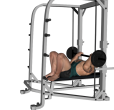 Bench Press - Smith Feet On Bench Reverse Wide
Bench Press - Smith Feet On Bench Reverse Wide
Benefits: A machine allows someone to lift heavier weights and thus build more strength quicker. The reverse grip makes the exercise more difficult.
Purpose: This exercise increases strength and strength speed, and produces greater functional strength for pressing movements.
Beginner Chest Triceps Anterior Delts Strength Smith Machine Flat Bench Push Compound Gym
General Info: The chest is composed of the Pectoralis Major and the Pectoralis Minor. The Pec Major attaches to the upper arm and pulls the upper arm across the chest. The Pec Minor lies mostly underneath the Pec Major and draws the shoulder blade down and forward.
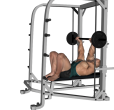 Bench Press - Smith Feet On Bench Wide
Bench Press - Smith Feet On Bench Wide
Benefits: A machine allows someone to lift heavier weights and thus build more strength quicker.
Purpose: This exercise increases strength and strength speed, and produces greater functional strength for pressing movements.
Beginner Chest Triceps Anterior Delts Strength Smith Machine Flat Bench Push Compound Gym
General Info: The chest is composed of the Pectoralis Major and the Pectoralis Minor. The Pec Major attaches to the upper arm and pulls the upper arm across the chest. The Pec Minor lies mostly underneath the Pec Major and draws the shoulder blade down and forward.
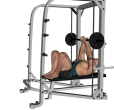 Bench Press - Smith Feet Up Close Grip Reverse
Bench Press - Smith Feet Up Close Grip Reverse
Benefits: This exercise works both heads of the triceps with a heavier weight than can typically be done with dumbbells.
Purpose: This exercise is used to target the triceps muscle to develop size, definition, strength, endurance and power.
Beginner Triceps Chest Shoulders Strength Smith Machine Flat Bench Push Compound Gym
General Info: The triceps is a straight muscle with three heads. The long head straightens the elbow, adducts the shoulder (brings it from a side position to the body) and extends the shoulder (brings the arm from a front position down to the body). The lateral head (outer head) straightens the elbow. The medial head also straightens the elbow.
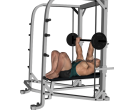 Bench Press - Smith Feet Up Flat Reverse Wide
Bench Press - Smith Feet Up Flat Reverse Wide
Benefits: A machine allows someone to lift heavier weights and thus build more strength quicker.
Purpose: This exercise increases strength and strength speed, and produces greater functional strength for pressing movements.
Beginner Chest Triceps Anterior Delts Strength Smith Machine Flat Bench Push Compound Gym
General Info: The chest is composed of the Pectoralis Major and the Pectoralis Minor. The Pec Major attaches to the upper arm and pulls the upper arm across the chest. The Pec Minor lies mostly underneath the Pec Major and draws the shoulder blade down and forward.
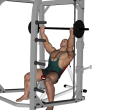 Bench Press - Smith Incline Reverse Wide
Bench Press - Smith Incline Reverse Wide
Benefits: A machine allows someone to lift heavier weights and thus build more strength quicker. The reverse grip makes the exercise more difficult.
Purpose: This exercise increases strength and strength speed, and produces greater functional strength for pressing movements.
Beginner Chest Triceps Anterior Delts Strength Smith Machine Incline Bench Push Compound Gym
General Info: The chest is composed of the Pectoralis Major and the Pectoralis Minor. The Pec Major attaches to the upper arm and pulls the upper arm across the chest. The Pec Minor lies mostly underneath the Pec Major and draws the shoulder blade down and forward.
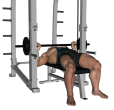 Bench Press - Smith Machine
Bench Press - Smith Machine
Benefits: A machine allows someone to lift heavier weights and thus build more strength quicker.
Purpose: This exercise increases strength and strength speed, and produces greater functional strength for pressing movements.
Beginner Chest Triceps Anterior Delts Strength Smith Machine Flat Bench Push Compound Gym
General Info: The chest is composed of the Pectoralis Major and the Pectoralis Minor. The Pec Major attaches to the upper arm and pulls the upper arm across the chest. The Pec Minor lies mostly underneath the Pec Major and draws the shoulder blade down and forward.
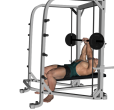 Bench Press - Smith Machine Close Grip
Bench Press - Smith Machine Close Grip
Benefits: This exercise works both heads of the triceps with a heavier weight than can typically be done with dumbbells.
Purpose: This exercise is used to target the triceps muscle to develop size, definition, strength, endurance and power.
Beginner Triceps Chest Shoulders Strength Smith Machine Flat Bench Push Compound Gym
General Info: The triceps is a straight muscle with three heads. The long head straightens the elbow, adducts the shoulder (brings it from a side position to the body) and extends the shoulder (brings the arm from a front position down to the body). The lateral head (outer head) straightens the elbow. The medial head also straightens the elbow.
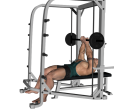 Bench Press - Smith Machine Close Grip Reverse
Bench Press - Smith Machine Close Grip Reverse
Benefits: This exercise works both heads of the triceps with a heavier weight than can typically be done with dumbbells. The reverse grip makes this exercise more difficult.
Purpose: This exercise is used to target the triceps muscle to develop size, definition, strength, endurance and power.
Beginner Triceps Chest Shoulders Strength Smith Machine Push Compound Gym
General Info: The triceps is a straight muscle with three heads. The long head straightens the elbow, adducts the shoulder (brings it from a side position to the body) and extends the shoulder (brings the arm from a front position down to the body). The lateral head (outer head) straightens the elbow. The medial head also straightens the elbow.
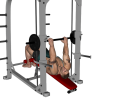 Bench Press - Smith Machine Decline
Bench Press - Smith Machine Decline
Benefits: This exercise works the chest muscles with a focus on your lower pecs.
Purpose: This exercise is used to target the lower pecs muscle to develop size, definition, strength, endurance and power.
Beginner Chest Triceps Shoulders Strength Smith Machine Decline Bench Push Compound Gym
General Info: The chest is composed of the Pectoralis Major and the Pectoralis Minor. The Pec Major attaches to the upper arm and pulls the upper arm across the chest. The Pec Minor lies mostly underneath the Pec Major and draws the shoulder blade down and forward.
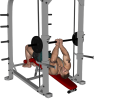 Bench Press - Smith Machine Decline Close
Bench Press - Smith Machine Decline Close
Benefits: The exercise eliminates isolates the triceps.
Purpose: This exercise works primarily the triceps.
Beginner Chest Triceps Shoulders Strength Smith Machine Decline Bench Push Compound Gym
General Info: The triceps is a straight muscle with three heads. The long head straightens the elbow, adducts the shoulder (brings it from a side position to the body) and extends the shoulder (brings the arm from a front position down to the body). The lateral head (outer head) straightens the elbow. The medial head also straightens the elbow.
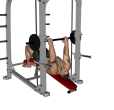 Bench Press - Smith Machine Decline Reverse
Bench Press - Smith Machine Decline Reverse
Benefits: This exercise works the chest muscles with a focus on your lower pecs.
Purpose: This exercise is used to target the lower pecs muscle to develop size, definition, strength, endurance and power.
Beginner Chest Triceps Shoulders Strength Smith Machine Decline Bench Push Compound Gym
General Info: The chest is composed of the Pectoralis Major and the Pectoralis Minor. The Pec Major attaches to the upper arm and pulls the upper arm across the chest. The Pec Minor lies mostly underneath the Pec Major and draws the shoulder blade down and forward.
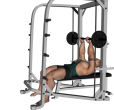 Bench Press - Smith Machine Flat
Bench Press - Smith Machine Flat
Benefits: A machine allows someone to lift heavier weights and thus build more strength quicker.
Purpose: This exercise increases strength and strength speed, and produces greater functional strength for pressing movements.
Beginner Chest Triceps Anterior Delts Strength Smith Machine Flat Bench Push Compound Gym
General Info: The chest is composed of the Pectoralis Major and the Pectoralis Minor. The Pec Major attaches to the upper arm and pulls the upper arm across the chest. The Pec Minor lies mostly underneath the Pec Major and draws the shoulder blade down and forward.
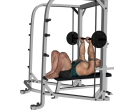 Bench Press - Smith Machine Flat Feet Up
Bench Press - Smith Machine Flat Feet Up
Benefits: Placing your feet on the end of the bench reduces the tendency to arch the back.
Purpose: Benefits A machine allows someone to lift heavier weights and thus build more strength quicker.
Beginner Chest Triceps Anterior Delts Strength Smith Machine Flat Bench Push Compound Gym
General Info: The chest is composed of the Pectoralis Major and the Pectoralis Minor. The Pec Major attaches to the upper arm and pulls the upper arm across the chest. The Pec Minor lies mostly underneath the Pec Major and draws the shoulder blade down and forward.
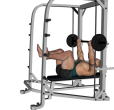 Bench Press - Smith Machine Flat Feet Up Reverse
Bench Press - Smith Machine Flat Feet Up Reverse
Benefits: A machine allows someone to lift heavier weights and thus build more strength quicker. The reverse grip makes this exercise more difficult.
Purpose: This exercise increases strength and strength speed, and produces greater functional strength for pressing movements.
Beginner Chest Triceps Anterior Delts Strength Smith Machine Flat Bench Push Compound Gym
General Info: The chest is composed of the Pectoralis Major and the Pectoralis Minor. The Pec Major attaches to the upper arm and pulls the upper arm across the chest. The Pec Minor lies mostly underneath the Pec Major and draws the shoulder blade down and forward.
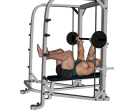 Bench Press - Smith Machine Flat Feet Up Wide
Bench Press - Smith Machine Flat Feet Up Wide
Benefits: A machine allows someone to lift heavier weights and thus build more strength quicker.
Purpose: This exercise increases strength and strength speed, and produces greater functional strength for pressing movements.
Beginner Chest Triceps Anterior Delts Strength Smith Machine Flat Bench Push Compound Gym
General Info: The chest is composed of the Pectoralis Major and the Pectoralis Minor. The Pec Major attaches to the upper arm and pulls the upper arm across the chest. The Pec Minor lies mostly underneath the Pec Major and draws the shoulder blade down and forward.
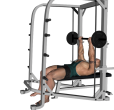 Bench Press - Smith Machine Flat Reverse
Bench Press - Smith Machine Flat Reverse
Benefits: A machine allows someone to lift heavier weights and thus build more strength quicker. The reverse grip makes this exercise more difficult.
Purpose: This exercise increases strength and strength speed, and produces greater functional strength for pressing movements.
Beginner Chest Triceps Anterior Delts Strength Smith Machine Flat Bench Push Compound Gym
General Info: The chest is composed of the Pectoralis Major and the Pectoralis Minor. The Pec Major attaches to the upper arm and pulls the upper arm across the chest. The Pec Minor lies mostly underneath the Pec Major and draws the shoulder blade down and forward.
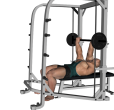 Bench Press - Smith Machine Flat Reverse Wide
Bench Press - Smith Machine Flat Reverse Wide
Benefits: A machine allows someone to lift heavier weights and thus build more strength quicker. The reverse grip makes this exercise more difficult.
Purpose: This exercise increases strength and strength speed, and produces greater functional strength for pressing movements.
Beginner Chest Triceps Anterior Delts Strength Smith Machine Flat Bench Push Compound Gym
General Info: The chest is composed of the Pectoralis Major and the Pectoralis Minor. The Pec Major attaches to the upper arm and pulls the upper arm across the chest. The Pec Minor lies mostly underneath the Pec Major and draws the shoulder blade down and forward.
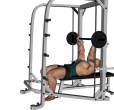 Bench Press - Smith Machine Flat Wide Grip
Bench Press - Smith Machine Flat Wide Grip
Benefits: A machine allows someone to lift heavier weights and thus build more strength quicker.
Purpose: This exercise increases strength and strength speed, and produces greater functional strength for pressing movements.
Beginner Chest Triceps Anterior Delts Strength Smith Machine Flat Bench Push Compound Gym
General Info: The chest is composed of the Pectoralis Major and the Pectoralis Minor. The Pec Major attaches to the upper arm and pulls the upper arm across the chest. The Pec Minor lies mostly underneath the Pec Major and draws the shoulder blade down and forward.
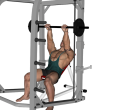 Bench Press - Smith Machine Incline
Bench Press - Smith Machine Incline
Benefits: This exercise works the chest muscles with a focus on your upper pecs.
Purpose: This exercise is used to target the upper pecs muscle to develop size, definition, strength, endurance and power.
Beginner Chest Triceps Shoulders Strength Smith Machine Incline Bench Push Compound Gym
General Info: The chest is composed of the Pectoralis Major and the Pectoralis Minor. The Pec Major attaches to the upper arm and pulls the upper arm across the chest. The Pec Minor lies mostly underneath the Pec Major and draws the shoulder blade down and forward.
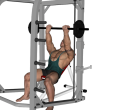 Bench Press - Smith Machine Incline Reverse
Bench Press - Smith Machine Incline Reverse
Benefits: A machine allows someone to lift heavier weights and thus build more strength quicker.
Purpose: This exercise increases strength and strength speed, and produces greater functional strength for pressing movements.
Beginner Chest Triceps Anterior Delts Strength Smith Machine Incline Bench Push Compound Gym
General Info: The chest is composed of the Pectoralis Major and the Pectoralis Minor. The Pec Major attaches to the upper arm and pulls the upper arm across the chest. The Pec Minor lies mostly underneath the Pec Major and draws the shoulder blade down and forward.
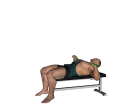 Bench Press - With Bands
Bench Press - With Bands
Benefits: Bands can be used to increase strength speed.
Purpose: This exercise increases strength and strength speed.
Beginner Chest Triceps Strength Band Flat Bench Push Compound Gym
General Info: The chest is composed of the Pectoralis Major and the Pectoralis Minor. The Pec Major attaches to the upper arm and pulls the upper arm across the chest. The Pec Minor lies mostly underneath the Pec Major and draws the shoulder blade down and forward.
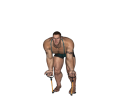 Biceps Curl - Bent Over Resistance Tube
Biceps Curl - Bent Over Resistance Tube
Benefits: This exercise is similar in effect to the Spider curl and does a good job of placing maximum tension on the biceps in the fully contracted position.
Purpose: This exercise works the biceps muscles but focuses also on the brachioradialis (a muscle that crosses the elbow joint and assists in rotating the forearm).
Beginner Biceps Forearms Shoulders Strength Resistance Tube Pull Gym Home
General Info: The biceps is a straight muscle which has two heads. The long head crosses both the elbow and the shoulder joints. It bends the arm at the elbow and raises the arm forward at the shoulder. The short head crosses the elbow joint and, in conjunction with the brachioradialis, supinates the hand.
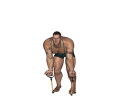 Biceps Curl - Bent Over Resistance Tube Alternate
Biceps Curl - Bent Over Resistance Tube Alternate
Benefits: This exercise is similar in effect to the Spider curl and does a good job of placing maximum tension on the biceps in the fully contracted position.
Purpose: This exercise works the biceps muscles but focuses also on the brachioradialis (a muscle that crosses the elbow joint and assists in rotating the forearm).
Beginner Biceps Forearms Shoulders Strength Resistance Tube Pull Gym Home
General Info: The biceps is a straight muscle which has two heads. The long head crosses both the elbow and the shoulder joints. It bends the arm at the elbow and raises the arm forward at the shoulder. The short head crosses the elbow joint and, in conjunction with the brachioradialis, supinates the hand.
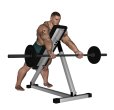 Biceps Curl - Overhang Barbell
Biceps Curl - Overhang Barbell
Benefits: This exercise is similar in effect to the Spider curl and does a good job of placing maximum tension on the biceps in the fully contracted position.
Purpose: This exercise works the biceps muscles.
Beginner Biceps Strength Barbell Flat Bench Pull Gym
General Info: The biceps muscle is a straight muscle with 2 heads. The long head crosses both the elbow and shoulder joints and bends the elbow and raises the arm forward at the shoulder. The short head of the biceps crosses the elbow joint and, in conjunction with the brachioradialis, supinates the hand.
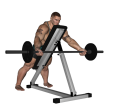 Biceps Curl - Overhang Barbell Wide Grip
Biceps Curl - Overhang Barbell Wide Grip
Benefits: This exercise is similar in effect to the Spider curl and does a good job of placing maximum tension on the biceps in the fully contracted position.
Purpose: This exercise works the biceps muscles.
Beginner Biceps Strength Barbell Flat Bench Pull Gym
General Info: The biceps muscle is a straight muscle with 2 heads. The long head crosses both the elbow and shoulder joints and bends the elbow and raises the arm forward at the shoulder. The short head of the biceps crosses the elbow joint and, in conjunction with the brachioradialis, supinates the hand.
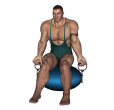 Biceps Curl - Resistance Tube Ball
Biceps Curl - Resistance Tube Ball
Benefits: This exercise isolates the biceps so that momentum does not come into play.
Purpose: This exercise strengthens the biceps.
Beginner Biceps Forearms Strength Fitness Ball Resistance Tube Pull Gym
General Info: The biceps muscle is a straight muscle with 2 heads. The long head crosses both the elbow and shoulder joints and bends the elbow and raises the arm forward at the shoulder. The short head of the biceps crosses the elbow joint and, in conjunction with the brachioradialis, supinates the hand..
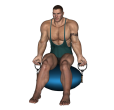 Biceps Curl - Resistance Tube Ball Alternate
Biceps Curl - Resistance Tube Ball Alternate
Benefits: This exercise isolates the biceps so that momentum does not come into play.
Purpose: This exercise strengthens the biceps.
Beginner Biceps Forearms Strength Fitness Ball Resistance Tube Pull Gym
General Info: The biceps muscle is a straight muscle with 2 heads. The long head crosses both the elbow and shoulder joints and bends the elbow and raises the arm forward at the shoulder. The short head of the biceps crosses the elbow joint and, in conjunction with the brachioradialis, supinates the hand..
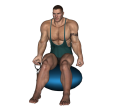 Biceps Curl - Resistance Tube Ball Single
Biceps Curl - Resistance Tube Ball Single
Benefits: This exercise isolates the biceps so that momentum does not come into play.
Purpose: This exercise strengthens the biceps.
Beginner Biceps Forearms Strength Fitness Ball Resistance Tube Pull Gym
General Info: The biceps muscle is a straight muscle with 2 heads. The long head crosses both the elbow and shoulder joints and bends the elbow and raises the arm forward at the shoulder. The short head of the biceps crosses the elbow joint and, in conjunction with the brachioradialis, supinates the hand..
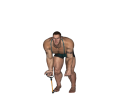 Biceps Curl - Resistance Tube Bent Over Single
Biceps Curl - Resistance Tube Bent Over Single
Benefits: This exercise isolates the biceps so that momentum does not come into play.
Purpose: This exercise strengthens the biceps.
Beginner Biceps Forearms Strength Resistance Tube Pull Gym Home
General Info: The biceps muscle is a straight muscle with 2 heads. The long head crosses both the elbow and shoulder joints and bends the elbow and raises the arm forward at the shoulder. The short head of the biceps crosses the elbow joint and, in conjunction with the brachioradialis, supinates the hand..
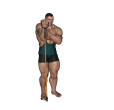 Biceps Curl - Resistance Tube Single
Biceps Curl - Resistance Tube Single
Benefits: This exercise works both heads of the biceps with a heavier weight than can typically be done with dumbbells.
Purpose: This exercise is used to target the biceps muscle to develop size, definition, strength, endurance and power.
Beginner Biceps Forearms Shoulders Strength Resistance Tube Pull Gym Home
General Info: The biceps is a straight muscle with two heads. The long head of the biceps crosses both the elbow and the shoulder joint. It bends the elbow and raises the arm forward at the shoulder. The short head crosses the elbow joint and, in conjunction with the brachioradialis, supinates the hand.
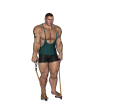 Biceps Curl - Resistance Tube Standing
Biceps Curl - Resistance Tube Standing
Benefits: This exercise works both heads of the biceps with a heavier weight than can typically be done with dumbbells.
Purpose: This exercise is used to target the biceps muscle to develop size, definition, strength, endurance and power.
Beginner Biceps Forearms Shoulders Strength Resistance Tube Pull Gym
General Info: The biceps is a straight muscle with two heads. The long head of the biceps crosses both the elbow and the shoulder joint. It bends the elbow and raises the arm forward at the shoulder. The short head crosses the elbow joint and, in conjunction with the brachioradialis, supinates the hand.
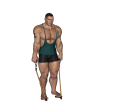 Biceps Curl - Resistance Tube Standing Alternate
Biceps Curl - Resistance Tube Standing Alternate
Benefits: This exercise works both heads of the biceps with a heavier weight than can typically be done with dumbbells.
Purpose: This exercise is used to target the biceps muscle to develop size, definition, strength, endurance and power.
Beginner Biceps Forearms Shoulders Strength Resistance Tube Pull Gym Home
General Info: The biceps is a straight muscle with two heads. The long head of the biceps crosses both the elbow and the shoulder joint. It bends the elbow and raises the arm forward at the shoulder. The short head crosses the elbow joint and, in conjunction with the brachioradialis, supinates the hand.
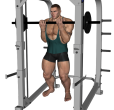 Biceps Curl - Smith Machine
Biceps Curl - Smith Machine
Benefits: This exercise works both heads of the biceps with a heavier weight than can typically be done with dumbbells.
Purpose: This exercise is used to target the biceps muscle to develop size, definition, strength, endurance and power.
Beginner Biceps Forearms Shoulders Strength Smith Machine Pull Gym
General Info: The biceps is a straight muscle with two heads. The long head of the biceps crosses both the elbow and the shoulder joint. It bends the elbow and raises the arm forward at the shoulder. The short head crosses the elbow joint and, in conjunction with the brachioradialis, supinates the hand.
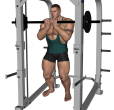 Biceps Curl - Smith Machine Close Grip
Biceps Curl - Smith Machine Close Grip
Benefits: This exercise works both heads of the biceps with a heavier weight than can typically be done with dumbbells.
Purpose: This exercise is used to target the biceps muscle to develop size, definition, strength, endurance and power.
Beginner Biceps Forearms Shoulders Strength Smith Machine Pull Gym
General Info: The biceps is a straight muscle with two heads. The long head of the biceps crosses both the elbow and the shoulder joint. It bends the elbow and raises the arm forward at the shoulder. The short head crosses the elbow joint and, in conjunction with the brachioradialis, supinates the hand.
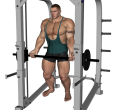 Biceps Curl - Smith Machine Wide Grip
Biceps Curl - Smith Machine Wide Grip
Benefits: This exercise works both heads of the biceps with a heavier weight than can typically be done with dumbbells.
Purpose: This exercise is used to target the biceps muscle to develop size, definition, strength, endurance and power.
Beginner Biceps Forearms Shoulders Strength Smith Machine Pull Gym
General Info: The biceps is a straight muscle with two heads. The long head of the biceps crosses both the elbow and the shoulder joint. It bends the elbow and raises the arm forward at the shoulder. The short head crosses the elbow joint and, in conjunction with the brachioradialis, supinates the hand.
 Biceps Curl - Squat Water Bottle
Biceps Curl - Squat Water Bottle
Benefits: This exercise isolates the biceps so that momentum does not come into play.
Purpose: This exercise strengthens the biceps.
Intermediate Biceps Forearms Shoulders Traps Strength Water Bottle Pull Home
General Info: The biceps muscle is a straight muscle with 2 heads. The long head crosses both the elbow and shoulder joints and bends the elbow and raises the arm forward at the shoulder. The short head of the biceps crosses the elbow joint and, in conjunction with the brachioradialis, supinates the hand..
 Biceps Curl - Squat Water Bottle Alternate
Biceps Curl - Squat Water Bottle Alternate
Benefits: This exercise isolates the biceps so that momentum does not come into play.
Purpose: This exercise strengthens the biceps.
Intermediate Biceps Forearms Shoulders Traps Strength Water Bottle Pull Home
General Info: The biceps muscle is a straight muscle with 2 heads. The long head crosses both the elbow and shoulder joints and bends the elbow and raises the arm forward at the shoulder. The short head of the biceps crosses the elbow joint and, in conjunction with the brachioradialis, supinates the hand..
 Biceps Curl - Squat Water Bottle Single
Biceps Curl - Squat Water Bottle Single
Benefits: This exercise isolates the biceps so that momentum does not come into play.
Purpose: This exercise strengthens the biceps.
Intermediate Biceps Forearms Shoulders Traps Strength Water Bottle Pull Home
General Info: The biceps muscle is a straight muscle with 2 heads. The long head crosses both the elbow and shoulder joints and bends the elbow and raises the arm forward at the shoulder. The short head of the biceps crosses the elbow joint and, in conjunction with the brachioradialis, supinates the hand..
 Biceps Curl - Squat Water Bottle Single Reverse
Biceps Curl - Squat Water Bottle Single Reverse
Benefits: This exercise isolates the biceps so that momentum does not come into play.
Purpose: This exercise strengthens the biceps.
Intermediate Biceps Forearms Shoulders Traps Strength Water Bottle Pull Home
General Info: The biceps muscle is a straight muscle with 2 heads. The long head crosses both the elbow and shoulder joints and bends the elbow and raises the arm forward at the shoulder. The short head of the biceps crosses the elbow joint and, in conjunction with the brachioradialis, supinates the hand..
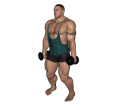 Biceps Curl - Standing Inner
Biceps Curl - Standing Inner
Benefits: This exercise works both heads of the biceps.
Purpose: This exercise is used to target the biceps muscle to develop size, definition, strength, endurance and power.
Beginner Biceps Forearms Shoulders Strength Dumbbell Pull Gym
General Info: The biceps is a straight muscle with two heads. The long head of the biceps crosses both the elbow and the shoulder joint. It bends the elbow and raises the arm forward at the shoulder. The short head crosses the elbow joint and, in conjunction with the brachioradialis, supinates the hand.
 Biceps Curl - Standing Water Bottle
Biceps Curl - Standing Water Bottle
Benefits: This exercise works both heads of the biceps with a heavier weight than can typically be done with dumbbells.
Purpose: This exercise is used to target the biceps muscle to develop size, definition, strength, endurance and power.
Beginner Biceps Forearms Shoulders Strength Water Bottle Pull Home
General Info: The biceps is a straight muscle with two heads. The long head of the biceps crosses both the elbow and the shoulder joint. It bends the elbow and raises the arm forward at the shoulder. The short head crosses the elbow joint and, in conjunction with the brachioradialis, supinates the hand.
 Biceps Curl - Standing Water Bottle Reverse Alternate
Biceps Curl - Standing Water Bottle Reverse Alternate
Benefits: This exercise works both heads of the biceps with a heavier weight than can typically be done with dumbbells.
Purpose: This exercise is used to target the biceps muscle to develop size, definition, strength, endurance and power.
Beginner Biceps Forearms Shoulders Strength Water Bottle Pull Home
General Info: The biceps is a straight muscle with two heads. The long head of the biceps crosses both the elbow and the shoulder joint. It bends the elbow and raises the arm forward at the shoulder. The short head crosses the elbow joint and, in conjunction with the brachioradialis, supinates the hand.
 Biceps Curl - Standing Water Bottle Single
Biceps Curl - Standing Water Bottle Single
Benefits: This exercise works both heads of the biceps with a heavier weight than can typically be done with dumbbells.
Purpose: This exercise is used to target the biceps muscle to develop size, definition, strength, endurance and power.
Beginner Biceps Forearms Shoulders Strength Water Bottle Pull Home
General Info: The biceps is a straight muscle with two heads. The long head of the biceps crosses both the elbow and the shoulder joint. It bends the elbow and raises the arm forward at the shoulder. The short head crosses the elbow joint and, in conjunction with the brachioradialis, supinates the hand.
 Biceps Curl - Suspended Chains
Biceps Curl - Suspended Chains
Benefits: This exercise is done with the addition of chains. The primary function of chains is to accommodate resistance. Chains are also a great means of weight loading (adding more weight to an exercise). Chains are also a great way for working the stabilizers.
Purpose: Benefits This exercise works both heads of the biceps and is great for working the stabilizers.
Beginner Biceps Forearms Shoulders Strength Chains Pull Gym
General Info: The biceps is a straight muscle with two heads. The long head of the biceps crosses both the elbow and the shoulder joint. It bends the elbow and raises the arm forward at the shoulder. The short head crosses the elbow joint and, in conjunction with the brachioradialis, supinates the hand.
 Biceps Curl - Water Bottle Alternate
Biceps Curl - Water Bottle Alternate
Benefits: This exercise works both heads of the biceps with a heavier weight than can typically be done with dumbbells.
Purpose: This exercise is used to target the biceps muscle to develop size, definition, strength, endurance and power.
Beginner Biceps Forearms Shoulders Strength Water Bottle Pull Home
General Info: The biceps is a straight muscle with two heads. The long head of the biceps crosses both the elbow and the shoulder joint. It bends the elbow and raises the arm forward at the shoulder. The short head crosses the elbow joint and, in conjunction with the brachioradialis, supinates the hand.
 Biceps Curl - Water Bottle Basic
Biceps Curl - Water Bottle Basic
Benefits: This exercise works both heads of the biceps.
Purpose: This exercise is used to target the biceps muscle to develop size, definition, strength, endurance and power.
Beginner Biceps Forearms Shoulders Strength Water Bottle Pull Home
General Info: The biceps is a straight muscle with two heads. The long head of the biceps crosses both the elbow and the shoulder joint. It bends the elbow and raises the arm forward at the shoulder. The short head crosses the elbow joint and, in conjunction with the brachioradialis, supinates the hand.
 Biceps Curl - Water Bottle Bent Over
Biceps Curl - Water Bottle Bent Over
Benefits: This exercise is similar in effect to the Spider curl and does a good job of placing maximum tension on the biceps in the fully contracted position.
Purpose: This exercise works the biceps muscles but focuses also on the brachioradialis (a muscle that crosses the elbow joint and assists in rotating the forearm).
Beginner Biceps Forearms Shoulders Strength Water Bottle Pull Home
General Info: The biceps is a straight muscle which has two heads. The long head crosses both the elbow and the shoulder joints. It bends the arm at the elbow and raises the arm forward at the shoulder. The short head crosses the elbow joint and, in conjunction with the brachioradialis, supinates the hand.
 Biceps Curl - Water Bottle Bent Over Alternate
Biceps Curl - Water Bottle Bent Over Alternate
Benefits: This exercise works both heads of the biceps with a heavier weight than can typically be done with dumbbells.
Purpose: This exercise is used to target the biceps muscle to develop size, definition, strength, endurance and power.
Beginner Biceps Forearms Shoulders Strength Water Bottle Pull Home
General Info: The biceps is a straight muscle with two heads. The long head of the biceps crosses both the elbow and the shoulder joint. It bends the elbow and raises the arm forward at the shoulder. The short head crosses the elbow joint and, in conjunction with the brachioradialis, supinates the hand.
 Biceps Curl - Water Bottle Bent Over Narrow
Biceps Curl - Water Bottle Bent Over Narrow
Benefits: This exercise is similar in effect to the Spider curl and does a good job of placing maximum tension on the biceps in the fully contracted position.
Purpose: This exercise works the biceps muscles but focuses also on the brachioradialis (a muscle that crosses the elbow joint and assists in rotating the forearm).
Beginner Biceps Forearms Shoulders Strength Water Bottle Pull Home
General Info: The biceps is a straight muscle which has two heads. The long head crosses both the elbow and the shoulder joints. It bends the arm at the elbow and raises the arm forward at the shoulder. The short head crosses the elbow joint and, in conjunction with the brachioradialis, supinates the hand.
 Biceps Curl - Water Bottle Seated
Biceps Curl - Water Bottle Seated
Benefits: This exercise isolates the biceps so that momentum does not come into play.
Purpose: This exercise strengthens the biceps.
Beginner Biceps Forearms Strength Water Bottle Chair Pull Home
General Info: The biceps muscle is a straight muscle with 2 heads. The long head crosses both the elbow and shoulder joints and bends the elbow and raises the arm forward at the shoulder. The short head of the biceps crosses the elbow joint and, in conjunction with the brachioradialis, supinates the hand..
 Biceps Curl - Water Bottle Seated Alternate
Biceps Curl - Water Bottle Seated Alternate
Benefits: This exercise isolates the biceps so that momentum does not come into play.
Purpose: This exercise strengthens the biceps.
Beginner Biceps Forearms Shoulders Traps Strength Water Bottle Chair Pull Home
General Info: The biceps muscle is a straight muscle with 2 heads. The long head crosses both the elbow and shoulder joints and bends the elbow and raises the arm forward at the shoulder. The short head of the biceps crosses the elbow joint and, in conjunction with the brachioradialis, supinates the hand..
 Biceps Curl - Water Bottle Seated Inner
Biceps Curl - Water Bottle Seated Inner
Benefits: This exercise isolates the biceps so that momentum does not come into play.
Purpose: This exercise strengthens the biceps.
Beginner Biceps Forearms Strength Water Bottle Chair Pull Home
General Info: The biceps muscle is a straight muscle with 2 heads. The long head crosses both the elbow and shoulder joints and bends the elbow and raises the arm forward at the shoulder. The short head of the biceps crosses the elbow joint and, in conjunction with the brachioradialis, supinates the hand..
 Biceps Curl - Water Bottle Seated Inner Alternate
Biceps Curl - Water Bottle Seated Inner Alternate
Benefits: This exercise isolates the biceps so that momentum does not come into play.
Purpose: This exercise strengthens the biceps.
Beginner Biceps Forearms Shoulders Traps Strength Water Bottle Chair Pull Home
General Info: The biceps muscle is a straight muscle with 2 heads. The long head crosses both the elbow and shoulder joints and bends the elbow and raises the arm forward at the shoulder. The short head of the biceps crosses the elbow joint and, in conjunction with the brachioradialis, supinates the hand..
 Biceps Curl - Water Bottle Seated Narrow Stance
Biceps Curl - Water Bottle Seated Narrow Stance
Benefits: This exercise isolates the biceps so that momentum does not come into play.
Purpose: This exercise strengthens the biceps.
Beginner Biceps Forearms Shoulders Traps Strength Water Bottle Chair Pull Home
General Info: The biceps muscle is a straight muscle with 2 heads. The long head crosses both the elbow and shoulder joints and bends the elbow and raises the arm forward at the shoulder. The short head of the biceps crosses the elbow joint and, in conjunction with the brachioradialis, supinates the hand..
 Biceps Curl - Water Bottle Seated Reverse
Biceps Curl - Water Bottle Seated Reverse
Benefits: This exercise isolates the biceps so that momentum does not come into play.
Purpose: This exercise strengthens the biceps.
Beginner Biceps Forearms Strength Water Bottle Chair Pull Home
General Info: The biceps muscle is a straight muscle with 2 heads. The long head crosses both the elbow and shoulder joints and bends the elbow and raises the arm forward at the shoulder. The short head of the biceps crosses the elbow joint and, in conjunction with the brachioradialis, supinates the hand..
 Biceps Curl - Water Bottle Seated Reverse Alternate
Biceps Curl - Water Bottle Seated Reverse Alternate
Benefits: This exercise isolates the biceps so that momentum does not come into play.
Purpose: This exercise strengthens the biceps.
Beginner Biceps Forearms Shoulders Traps Strength Water Bottle Chair Pull Home
General Info: The biceps muscle is a straight muscle with 2 heads. The long head crosses both the elbow and shoulder joints and bends the elbow and raises the arm forward at the shoulder. The short head of the biceps crosses the elbow joint and, in conjunction with the brachioradialis, supinates the hand..
 Biceps Curl - Water Bottle Seated Reverse Narrow
Biceps Curl - Water Bottle Seated Reverse Narrow
Benefits: This exercise isolates the biceps so that momentum does not come into play.
Purpose: This exercise strengthens the biceps.
Beginner Biceps Forearms Strength Water Bottle Chair Pull Home
General Info: The biceps muscle is a straight muscle with 2 heads. The long head crosses both the elbow and shoulder joints and bends the elbow and raises the arm forward at the shoulder. The short head of the biceps crosses the elbow joint and, in conjunction with the brachioradialis, supinates the hand..
 Biceps Curl - Water Bottle Seated Single
Biceps Curl - Water Bottle Seated Single
Benefits: This exercise isolates the biceps so that momentum does not come into play.
Purpose: This exercise strengthens the biceps.
Beginner Biceps Forearms Shoulders Traps Strength Water Bottle Chair Pull Home
General Info: The biceps muscle is a straight muscle with 2 heads. The long head crosses both the elbow and shoulder joints and bends the elbow and raises the arm forward at the shoulder. The short head of the biceps crosses the elbow joint and, in conjunction with the brachioradialis, supinates the hand..
 Biceps Curl - Water Bottle Seated Single Narrow
Biceps Curl - Water Bottle Seated Single Narrow
Benefits: This exercise isolates the biceps so that momentum does not come into play.
Purpose: This exercise strengthens the biceps.
Beginner Biceps Forearms Shoulders Traps Strength Water Bottle Chair Pull Home
General Info: The biceps muscle is a straight muscle with 2 heads. The long head crosses both the elbow and shoulder joints and bends the elbow and raises the arm forward at the shoulder. The short head of the biceps crosses the elbow joint and, in conjunction with the brachioradialis, supinates the hand..
 Biceps Curl - Water Bottle Seated Straight
Biceps Curl - Water Bottle Seated Straight
Benefits: This exercise isolates the biceps so that momentum does not come into play.
Purpose: This exercise strengthens the biceps.
Beginner Biceps Forearms Shoulders Traps Strength Water Bottle Chair Pull Home
General Info: The biceps muscle is a straight muscle with 2 heads. The long head crosses both the elbow and shoulder joints and bends the elbow and raises the arm forward at the shoulder. The short head of the biceps crosses the elbow joint and, in conjunction with the brachioradialis, supinates the hand..
 Biceps Curl - Water Bottle Seated Straight Alternate
Biceps Curl - Water Bottle Seated Straight Alternate
Benefits: This exercise isolates the biceps so that momentum does not come into play.
Purpose: This exercise strengthens the biceps.
Beginner Biceps Forearms Shoulders Traps Strength Water Bottle Chair Pull Home
General Info: The biceps muscle is a straight muscle with 2 heads. The long head crosses both the elbow and shoulder joints and bends the elbow and raises the arm forward at the shoulder. The short head of the biceps crosses the elbow joint and, in conjunction with the brachioradialis, supinates the hand.
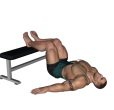 Bridge - Bench Body Lift
Bridge - Bench Body Lift
Benefits: This is a good exercise for core glute muscle development.
Purpose: This exercise is a controlled, balanced glute exercise for building tone and shape.
Beginner Glutes Hamstrings Abdominals Stretching Body Only Gym Home
General Info: The glutes consist of the gluteus maximus, gluteus medius, and gluteus minimus. They create hip joint motion to lift the thigh forward, lift the thigh to the side, rotate the leg inward, and rotate the thigh outward.
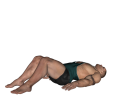 Bridge - Butt Lift
Bridge - Butt Lift
Benefits: This is a good exercise for core glute muscle development.
Purpose: This exercise is a controlled, balanced glute exercise for building tone and shape.
Beginner Glutes Stretching Body Only Gym Home
General Info: The glutes consist of the gluteus maximus, gluteus medius, and gluteus minimus. They create hip joint motion to lift the thigh forward, lift the thigh to the side, rotate the leg inward, and rotate the thigh outward.
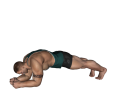 Butt Ups - Basic
Butt Ups - Basic
Benefits: This is a good exercise for core glute muscle development.
Purpose: This exercise is a controlled, balanced glute exercise for building tone and shape.
Beginner Glutes Abdominals Stretching Body Only Gym Home
General Info: The glutes consist of the gluteus maximus, gluteus medius, and gluteus minimus. They create hip joint motion to lift the thigh forward, lift the thigh to the side, rotate the leg inward, and rotate the thigh outward.
Could not find your favorite exercise in the list? Please start a discussion and post the name and the list of steps. We will try to add it as soon as we can.